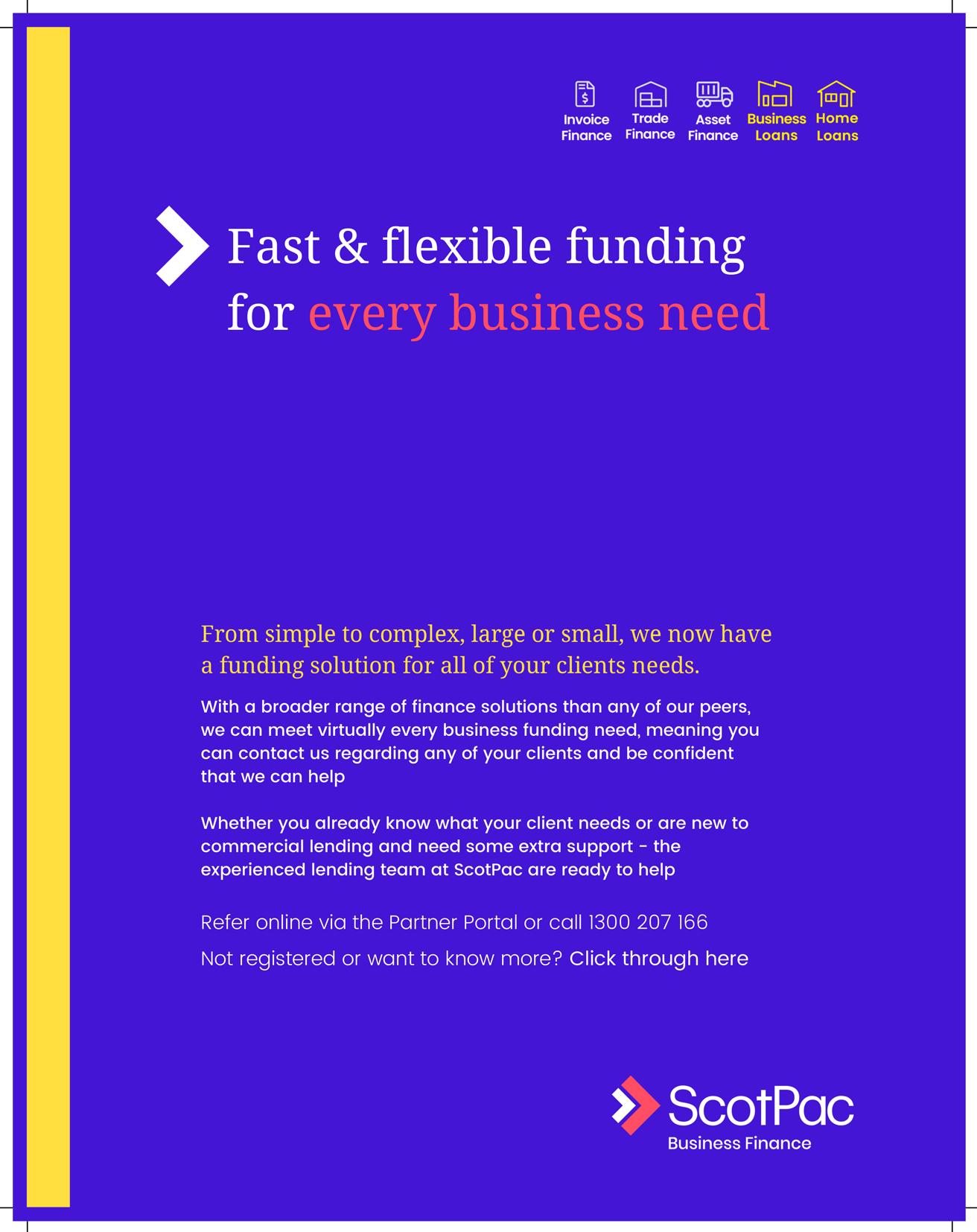but help is at hand

Topping off its 25th anniversary, Liberty has been recognised as Australia’s number one non-bank by the broker community
 John Mohnacheff
Liberty
John Mohnacheff
Liberty







but help is at hand

Topping off its 25th anniversary, Liberty has been recognised as Australia’s number one non-bank by the broker community
 John Mohnacheff
Liberty
John Mohnacheff
Liberty






The major banks join brokers at MPA’s annual roundtable to discuss the state of the market

Got a story or suggestion, or just want to find out some more information?
twitter.com/MPAMagazineAU
facebook.com/Mortgage ProfessionalAU
Turbulent times are bringing brokers to the fore

A look at the latest numbers as the housing downturn spreads
The value of dialogue as the MFAA continues its work to elevate brokers


Three lenders discuss opportunities in the FHB sector in the light of current market trends
Brokers across Australia reveal their top choice of non-bank lenders and what they want from a non-bank in 2022
Liberty’s group sales manager explains how strong partnerships with the third party channel have driven growth for brokers’ number one non-bank
A group of non-bank lenders talk about the solutions they can provide for small businesses in a challenging market for borrowers
Why making endless lists can be counterproductive to getting the most important tasks done
The key steps to take to ensure your business is well prepared for sale from day one

How partnerships have supercharged Lydian Finance’s rapid growth
Ultramarathon runner Taras Mencinsky also goes the distance for borrowers
Digital transformation of the industry is providing tech tools that give brokers a competitive edge

Our daily newsletter. Keep on top of property market trends, business strategy, and what industry leaders have to say.
www.mpamagazine.com.au
The heat might have come off the housing market, but the trust Australians place in mortgage brokers has never been greater. Brokers facilitated 68% of all new residential home loans in the three months to June 2022, according to the MFAA. This is the highest result ever for a June quarter, while the value of broker-settled home loans was $96.08bn – a record for any quarter.
It’s clear that brokers enjoy an unrivalled position, with two-thirds of Australian homebuyers relying on their expertise when it comes to finding a home loan.
The twin spectres of rising interest rates and inflation are starting to put a dent in property demand and real estate values, but it’s in times of economic turbulence that brokers come into their own. In the complex and fast-changing world of lending, brokers can guide customers through a myriad of products and credit policies to find the most suitable loans for their individual circumstances
Rising interest rates and inflation are putting a dent in the market, but it’s in times of economic turbulence that brokers come into their own
At the time of printing, the RBA had raised the official interest rates six times, from 0.10% to 2.60%. While refinancing was strong during COVID, recent rate rises have encouraged many homeowners to contact their brokers to get better deals.
PEXA’s latest report on refinancing shows that more than a million Australians refinanced their home loans in the last 12 months, saving $1,524 on average, while almost 2.3 million people were considering refinancing in the next two years. This indicates that brokers will continue to be in demand from borrowers wanting a better loan deal, backed up by the intrinsic value of the best interests duty.
In this issue, the importance of broker opinions and how they can shape the policies and actions of lenders is explored in the 2022 Brokers on Non-Banks report.
Hundreds of brokers ranked non-banks across 10 categories, including turnaround times, credit policy, product range, online platform and commission structure.
In MPA’s annual Major Banks Roundtable, CommBank, NAB, ANZ and Westpac discuss housing market trends, refinancing, competition, the broker channel and technology, as well as answering some tough questions from the two brokers present. In our Sector Focuses on the first home buyer market and SME lending, various lenders talk about market trends, the products they offer, and how they assist brokers and their clients. A Sector Focus on broker technology also shows how brokers can streamline their processes and customer interactions
MPA looks forward to continuing to share the latest industry insights and trends to support brokers as they guide their clients in making smart lending decisions
Antony Field, editor, MPAField
Anja Pannek, Aytekin Tank,
Copyright
Razon, Khaye Cortez
Success Manager Andi Zbojniewicz
Executive Officer Mike Shipley
Chief Operating Officer George Walmsley
Chief Commercial Officer Justin Kennedy Chief Information Officer

Chan Director – People and Culture Julia Bookallil
EDITORIAL ENQUIRIES tel: +612 8437 4784 antony.field@keymedia.com
SUBSCRIPTION ENQUIRIES tel: +61 2 8311 5831 • fax: +61 2 8437 4753 subscriptions@keymedia.com.au
ADVERTISING ENQUIRIES claire.tan@keymedia.com
Information Australia Pty
MORTGAGE
INTRODUCER





Sydney -2.3%

believe a broker has the expertise they need to find the right home loan
National housing values fell for the fourth consecutive month in August, with the downturn becoming more broad-based geographically, CoreLogic reports. Every capital city except Darwin is now in a housing downturn. A similar trend is occurring in most regional areas, apart from regional South Australia, which saw an increase in housing values.

Melbourne -1.2%
Brisbane -1.8%
Adelaide -0.1%
Perth -0.2%
Hobart -1.7%
Darwin 0.9%
Canberra -1.7%
Combined capitals -1.6%
were motivated to use a broker because they believe they deliver value
were motivated by the broker’s ability to secure a loan
with three or more properties use a broker to assist with complex loans
Combined regional -1.5% National -1.6%
With interest rates rising steadily since May, property prices started falling. Some homeowners, though, were able to sell when prices were still near their peak, seeing profits in the millions.
The total stock of properties listed for sale in July increased compared to last year, with new listings up 6.5% year-on-year nationally, due in part to the number of capital cities being in lockdown for at least some of July 2021. The 12.2% decline month-on-month reflected the typically quieter winter conditions.
$561,781
Nationally, home values have fallen just 2% from the end of April to July, and regions have seen an average median value decline of 5.9%. Below are the 20 SA3 regions where the deposit hurdle has most improved from March to June this year.
REGIONS WITH GREATEST REDUCTION IN YEARS TO SAVE A 20%
Region Years to save Mar 22 Jun 22
Manly, Sydney 23.2 20.7
Pittwater, Sydney 28.5 25.9
Warringah, Sydney 22.7 20.6
Ku-ring-gai, Sydney 27.6 26 Leichhard, Sydney 20 18.5 Darebin-South, Melbourne 12.4 10.8 Monash, Melbourne 18.1 16.8
$512,531
Sherwood-Indooroopilly, Brisbane 11.6 10.3 Noosa, Qld 22.4 21.1 Richmond Valley – Coastal, NSW 25.9 24.7 Bayside, Melbourne 19 17.8
$808,287
$594,006
$738,321
Eastern Suburbs – North, Sydney 19.6 18.5 Canterbury, Sydney 17.2 16.2
Cronulla-Miranda-Caringbah, Sydney 20.1 19 North Sydney – Mosman 15.9 14.9


Manningah – West, Melbourne 21.2 20.2
Boroondara, Melbourne 17.4 16.4
Eastern Suburbs – South, Sydney 17.2 16.3
Whitehorse – East, Melbourne 16.1 15.2
Yarra Ranges, Melbourne 13.4 12.6
The total number of
fell 17.2% in seasonally adjusted terms in July, led by a sharp decline in approvals for private sector dwelling, excluding houses, which slipped by 43.5%, driven by a lack of
for large
responding to vulnerable customers.
The MFAA continues to deliver relevant and timely education to support the shifting needs of our members and the industry. We’ve seen the success of this recently with our commercial lending workshops across the country. More mortgage brokers are writing commercial loans than ever before, according to the latest MFAA Industry Intelligence Service research.
COMING INTO the role of CEO at the MFAA, I knew the mortgage and finance broking industry was in excellent shape.
The data on our industry tells a clear story of trust and value. Brokers are using their expertise to ensure clients are making respon sible borrowing decisions.
Mortgage broker market share has been breaking records each quarter. In fact, the value of mortgages settled by brokers in the June 2022 quarter was the highest ever, according to MFAA research.
collectively take the industry to the next level.
Throughout the challenges of the past few years, MFAA advocacy has played a crucial role in elevating the role of mortgage and finance brokers. The MFAA’s core focus will continue to be advocating proactively to both promote the strengths of the industry and remain at the forefront of evolving policy.
My approach to advocacy is one of ‘no surprises’. Constant dialogue helps us understand member and stakeholder concerns and ensures we remain ahead of the curve
The MFAA New Commercial Broker workshops focused on giving mortgage brokers the foundational knowledge and skills they need to expand their businesses into commercial finance.
I also know how incredibly rewarding it is to be part of this industry. If we fast-forward, I would like to see broking regarded as a career of choice for many. The MFAA is actively supporting new-to-industry brokers through workshops and resources to help them set up their businesses and have the best chance of success.
While everyone is very busy and customer enquiry levels are high, I think we collectively have an opportunity for the first time in a number of years to lift our sights and look ahead to what the future could hold.
Complaints remain low. The latest AFCA data shows complaints about mortgage brokers continue to comprise less than 0.50% of all banking and finance complaints. The differ ences in arrears between the broker channel and proprietary channels are negligible.
This position is a testament to the experi ence, energy and passion brokers bring to working with their customers and how the industry has evolved and continues to do so.
In the current environment of economic uncertainty, rising interest rates and softening property prices, the value proposition of a broker shines. Customers are actively seeking out their brokers to help them navigate options for their future.
While there are and will be challenges, we have the chance in this great position to
on regulation. Through constructive dialogue with all stakeholders, we can shape our industry together and continue our journey from industry to profession for future generations of brokers, for the benefit of customers.
I firmly believe that is the pathway to a sustainable, healthy industry with a growing ‘pie’ for everyone, and I will maintain my focus on clearing a path for broking to grow as an industry, maintaining trust in the eyes of customers and key stakeholders.
Another important role of the MFAA is education and professional development. The association was at the forefront of developing modules on the best interests duty, ethical decision-making in the industry, and the Banking Code of Practice, including

Innovation in technology, AI and automa tion, use of data, and the digitisation of many aspects of the mortgage, lending and customer experience are occurring. This will shape customer expectations and how brokers run their businesses, manage their teams and interact with their customers.
As these changes emerge and are adopted in the industry, one thing will remain core. Brokers will remain at the centre of how Australians make some of the most important decisions in their lives – be that buying a home, building wealth through property, or starting or growing a business. Our industry will continue to hold this position, anchored in trust and confidence.
I see nothing but opportunity and look forward to reflecting in years to come on how far the industry has come.
My approach to advocacy is one of ‘no surprises’. Constant dialogue helps us understand concerns and ensures we remain ahead of the curve on regulationAnja Pannek is CEO of the MFAA. She has over 20 years’ experience in the finance sector and a proven track record of leading successful businesses within the third party channel.
GOT AN OPINION THAT COUNTS? Email antony.field@keymedia.com
With broker market share breaking records, it’s time to take the industry to the next level, says Anja Pannek

Brokers have a need for speed when it comes to their dealings with non-banks, while interest rates are much less of an issue, despite dominating newspaper headlines
TIME IS of the essence for non-banks. That’s what brokers demand of them, and the data shows it’s becoming even more of a priority.
MPA’s Brokers on Non-Banks 2022 survey shows turnaround time is brokers’ number one concern. It was also their top priority last year, but by a smaller margin.
According to one respondent, non-banks are listening. “I have just noticed in the last 12 months that all lenders’ turnaround times seem to have improved,” the broker said.
The entire data set reveals that nearly three-quarters of brokers said turnaround times had improved or remained about the same. Only 27% said times had worsened – a drop from 33% in 2021.

Possibly even more eye-catching is brokers’ second most important concern: commission structure. It was the lowest concern in MPA’s 2021 survey.
Brokers evidently feel strongly that nonbanks ought to address this issue better.
“One way to show their commitment to the broker channel would be to remove the
ludicrous net of offset commission payments and do something to sort out clawback issues,” said one respondent.
Renewed broker worries about getting paid are in line with trends in other recent MPA surveys, such as this year’s Brokers on Aggregators report, suggesting a resurgence of more traditional priorities.
Third-ranked training and development and fourth-placed BDM support also under score broker concerns about keeping up with the competition as the specialist lending environment continues to change rapidly in terms of macro factors, products and technology.
Non-banks generally have higher rates than mainstream lenders, but MPA’s 2022 survey shows that rates are only of middling importance to brokers this year, despite being the focus of a massive amount of media coverage since the Reserve Bank of Australia started its tightening cycle in May.
Interest rates ranked fifth equal in the survey, tying with online platforms and
services in terms of importance to brokers, higher than its eighth place in 2021 but well below the number one concern of 2020.
While there were a mix of comments about whether rates were high or not, brokers often acknowledged that they were appropriate.
“Although rates are higher, this is not a major obstacle,” said one broker.
The latest national accounts data show that savings levels are still just above what they were in 2019, and that people squir relled away cash at around four times the normal pace during parts of 2020 and 2021.
Record numbers of borrowers have also used the period of ultra-loose monetary policy during the pandemic to lock in fixed rates, affording some protection from more expensive money for the time being. Financial product comparison website RateCity’s anal ysis showed in June that nearly two out of five home loans remain fixed, with a large group of people not coming off their fixed rates until mid to late 2023.
Aged 56 and above
Writes $20m–$40m worth of mortgages a year
Has been in the industry for more than 15 years
Is most likely to live in NSW or Vic
In this year’s survey, brokers were asked to rank non-bank lenders across 10 categories: BDM support; brand recognition; commission structure; communications, training and development; credit policy; interest rates; online platform and services; product diversification opportunities; product range; and turnaround times. Brokers could rank the non-banks with a score out of five in each category.
Only those institutions that achieved a response rate of at least 10% of brokers for each non-bank were included in the final list.
The survey also recorded 322 broker responses on their preferred non-banks in these areas: specialist lending; first home buyers; property investors; commercial; alt doc; SMSF; and foreign non-residents.
MPA asked the brokers a series of questions relating to their business with non-bank lenders, as well as which non-bank they would like to see added to their aggregator’s panel, but these did not influence the overall score.


The proportion of brokers’ loans put through non-banks is down, but brokers continue to underestimate how much they need alternatives to the main lenders for customers requiring flexible solutions
MPA’S SURVEY showed that 63% of brokers increased the amount of loans put through non-banks in the last year, compared to a 69% increase in 2021. It also showed that, of those putting the lowest proportion (less than 20%) of loans through a non-bank, the figure was 44%, versus 45% in 2021.

This was higher use of non-banks than brokers had forecast, likely reflecting the tougher lending criteria at traditional banks and the larger number of self-employed customers seeking flexible lenders not fazed by unstable income records during COVID.
At the top end of the table, just 13% of brokers put more than 60% of their loans through non-banks this year, up from 12% last year but down from 19% in 2020.
The expected proportion of loans forecast to go through non-banks in 2023 is essentially in line with expectations seen in last year’s survey, but with interest rates still rising for now and tighter lending at banks, brokers may once again come to rely on non-banks more than they currently anticipate.

“There’s a great opportunity now and going forward over the next 24 to 48 months for
non-banks to really increase on their market share,” says Peter White, FBAA managing director, who was not part of the survey.
“Even if times get a little bit tough for borrowers going forward – which it will for many – there are lots of options that can be considered. Brokers just need to be wellskilled and well-versed as to what those options are.”
The best interests duty requiring brokers to provide a suite of lending options is another factor in non-banks’ favour.
“They are on just about every aggregator panel in some shape or form or another … if it could well be in the best interest of the client, then [brokers] look at a non-bank.”
Brokers continued to turn to non-banks mainly because they take a wider view of their customers than just looking at their credit scores, with around 24% of brokers saying that was the main reason to use non-banks.
Non-banks are particularly strong in the self-employed sector due to the messy paperwork that regular banks are less able to consider when looking at an application. Life events and fluctuating incomes are also regular fodder for alternative lenders.
Contractors or labourers such as construction workers are a case in point. Such groups generally continued to be employed over the pandemic, but some had difficulty maintaining robust tax records.
One survey respondent said non-banks




“provide clients who are self-employed with options that the banks will not consider. Applicants may not have lodged income tax returns, and this is a concern for banks”.
Non-banks are the only option for such people with truncated paperwork.
Another broker said specialist lending “covers clients who otherwise wouldn’t be able to proceed anywhere else”.
The second, third and fourth most popular reasons why brokers would use a non-bank are all related to this point: banks have tightened their credit policies; the client lacks standard documentation such as payslips; and regulatory changes have ruled out a normal bank as an option for the client.

Lack of standard documentation was bottom of the list of reasons in 2021 and didn’t even make the list in 2020. The fact that it has jumped to third in 2022 suggests that brokers are seeing a rise in borrowers with unusual income records due to seasonality, business disruption and the rise of the gig economy.
One respondent said the existence of products such as near prime at non-banks “has meant homeownership has been possible for clients that did not fit typical lending criteria”.


Borrowers continue to see non-banks as a good option, and a more competitive market means that brokers are becoming more discerning when it comes to rating institutions
IN TERMS of brokers’ ratings of the benefits of using a non-bank, 2022 marks a watershed year not for any single financial organisation but for the industry as a whole. This is reflected in the extreme closeness of the results, underscoring more competition between non-banks.

The top three non-banks overall won just one gold in each of the 10 categories. Pepper Money won gold for the fifth year in a row for its BDM support, Liberty topped credit policy, and Firstmac won gold for product range.
Indeed, non-banks in the middle of the field won more golds than those on the podium, with fourth-placed RedZed winning
two and seventh-placed La Trobe Financial winning three.
This year, it was silver that decided first place, with Liberty collecting six second places, showing strong consistency across a range of criteria.
But final tallies across categories were all much lower this year; the top overall score of 3.659 would only have been good enough for sixth place in the 2021 contest.
The even distribution of the field in 2022 may also have been due to the larger field of entrants who did not make the winners list this year, but still thinned broker votes at the top of the table.

The organisation that brokers most wanted to see added to their aggregator panel this year was also the overall winner – Liberty. Last year’s winner in this area, Mortgage Ezy, slipped to the number three choice, while RedZed came second.
While interest rates only appear mid-table when it comes to importance to brokers dealing with non-banks, they continue to be the major barrier to doing more business with them. This suggests there is a limit to how much share non-banks can take from main stream banks, or at least it shows a dynamic balance that can only change if more borrowers get turned away from regular lenders.
More than half of all brokers said nonbanks’ higher rates and fees were stopping them from using them more.



“Rates are too high still,” said one broker. “I understand there are higher risks with self-declared income, but if the rates reduced
with LVR that would be great.”
Another said, “They are expensive; they have a lot more upfront costs.”
Despite such comments, several respond ents praised the rates available at nonbanks, saying they were “low”, “good”, or







“Rates are too high still. I understand there are higher risks with self-declared income, but if the rates reduced with LVR that would be great” Survey respondent

Your customers can update their payment date, frequency and amount to align with their pay cycle, helping make repayments simpler and easier.
Whether a customer is saving for a holiday, or their family is entering a new life stage, eligible customers can take a three to 12 month repayment holiday to give them more financial flexibility.
Eligible CommBank customers can enjoy exclusive offers and savings through our growing range of partnerships – including More, Amber, Little Birdie and :Different.2
We support eligible owner occupied home loan customers when they need it the most with complimentary protection, covering repayments for around 12 months if an eligible borrower, spouse or dependant passes away or becomes terminally ill.3
Things you should know:
1 Based on CBA competitor comparison of product features and the ability to self-serve changes to home loans.
2 More, Amber, Little Birdie and :Different are partners of CBA. You should review their respective product offerings and terms and conditions before making any decision about their services.
3 Loan and age eligibility requirements and other limitations and exclusions may apply. Home Loan Compassionate Care is underpinned by a group policy held by us with the insurer, AIA Australia Limited ABN 79 004 837 861 AFSL 230043 (AIA Australia). AIA Australia is not part of CBA. Applications are subject to credit approval. Full terms and conditions will be included in our Loan Offer. Fees and charges are payable. Commonwealth Bank of Australia ABN 48 123 123 124 AFSL and Australian credit licence 234945.
Life can be unpredictable and things can change quickly, which is why we support customers with Australia’s most flexible home loa
“competitive”, often tying in praise for rates with praise for the product, such as a “higher borrowing capacity for clients”.
The second biggest barrier to using a non-bank lender was a lack of brand aware ness, a repeat of the survey result in 2021 and 2020. However, non-banks may be beginning to make headway in this depart ment, with only 20% of respondents saying brand awareness was low, compared to 27% last year.
The proportion of brokers who said their clients were typically open to considering non-bank products remained high in 2022, at 89% versus 90% last year. In 2020, the figure was 70%.












Survey comments backed up the higher levels of trust in non-banks than a few years ago. “[There are an] increasing number of customers for these types of processes and policy,” said one respondent.
La Trobe Financial took home the gold medal for brand recognition for the second year in a row, suggesting its marketing is effec tive. But overall, many brokers still believe non-banks need to do more in this area.

“I think they could do a better job of banding together to get awareness out to the general population,” said one respondent, adding that “some people are afraid of non-banks because they don’t understand them”.
Another agreed, saying that “non-bank lenders really need to differentiate them selves from the majors if they wish to secure the bulk of brokers’ business”.
At the same time, the image of banks was not so great in the eyes of a few brokers. “Banks can have limited policy criteria and operate like robots,” said one respondent.
Another criticised mainstream banks for lifting rates too quickly in the current envi ronment. “As soon as the RBA increased their rates the big banks went along for the ride and increased their rates yet again, making them less competitive,” a broker said.



Both positive and negative experiences abound for brokers, but on the whole, tech gains seem to be improving turnaround times more than they did a year ago

NEARLY THREE-QUARTERS of brokers this year said turnaround times had improved or remained about the same. Only 27% said times had worsened – a drop from 33% in
2021. This suggests the tech improvements seen in recent years are finally paying off for non-banks and brokers. Some non-banks were praised by brokers for having same-day

turnarounds, but improvements seem to be across the board.
Brokers cited an increase in staffing levels and people being back in the office post-COVID as a factor, with BDMs easy to reach to move things along.
“In 2021, times were terrible due to the pandemic,” said one respondent.
Brokers also said non-banks were doing better in this area than banks: “[Times have] definitely improved with the major banks not able to deliver with the volumes … the same products are available with nonbank lenders who have capacity to take more customers on board and deliver.”
Negative comments around turnaround cited a lack of knowledge about processes, and difficulty in contacting the right people as factors hurting time to decision.
“[There are] too many gatekeepers who don’t understand the file or documents sent, returning files that are correct. Would a phone call really kill them over emails?” said one respondent.
RedZed, which won gold in this category, was described by several brokers as very efficient, while one broker called bronze winner Firstmac “a joy to deal with”.
But others such as Resimac and La Trobe Financial were panned for slower turna round times. This slowness in turnaround










likely weighed on La Trobe Financial in the overall rankings, given that it won gold in three other categories.
Other brokers cited structural or cyclical factors as reasons for better or worse turnaround times.




“There have been periods post promo tional offers where turnaround times have worsened, but this is the same for any major bank,” said one.
Another respondent said times were quicker “more due to customer involvement in lending rather than good management by institutions”.
When asked how non-bank lenders could improve their service levels, brokers’ responses were different to last year, when better technology was at the top of the wish list by several percentage points. This year, better-trained BDMs and credit successors tied with better tech as ways non-banks could improve their service, suggesting that many brokers are happy with the improvements over the last 12 months.
Fintech is an area that continues to evolve rapidly, with banks and non-banks investing heavily in better systems to improve the broker experience. Providing a seamless experience for brokers is a key way that non-banks compete for custom.


Simplifying the income verification process ranked third on brokers’ wish lists for improving service, and better tech nology plays a key role in this.




There were three chances to win bottle of liquor by answering the question, ‘Do you think the non-banks have provided enough competition to the banks over the last year? Why/why not?’
Winning comment for a bottle of Johnnie Walker Black Label 12-year-old blended Scotch whisky: “Yes, but due to lack of political power, the banks still have a decided advantage. Funny how clawback is supposed to stop churning by brokers, but the banks churn all the time with their cashback rebates to borrowers.”
Winning comment for a bottle of Don Julio Reposado tequila:
Winning comment for a bottle Glenfiddich 12-year-old single malt Scotch whisky: “Yes, clients need flexibility, and the non-banks are delivering on this – however, majors have clawed back ground with the introduction of streamlined policy for self-employed clients.”
“Yes, turnaround times and interest rates have been the most enticing part of non-bank lenders. Customers are happy to go for a lender without big brand names to keep money in their pockets. Non-bank lenders do, however, need to up their ante with online banking apps/platforms for customers post settlement.”

“Yes – but it is the brokers that continue to look for the majors and not educate their clients on other choices. Also, with majors closing branches, now is a great time to spread the love amongst all lenders.”

Close but no cigar: “Non-banks don’t really compete with banks, so no. They provide alternatives for borrowers that banks cannot service due to compliance restraints, so non-bank lenders essentially compete with each other and not the banks.”
“Not too bad, but they can be very much the same regarding lending limits. Lenders should consider larger loan amounts with reduced LVRs for single security, particularly in an expensive property market like Sydney – limit loan sizes to $1.5m–$2m is a little restrictive.”

















What challenges and opportunities do you see for the next six to 12 months?
Barry Saoud, general manager, mortgages and commercial lending: In this rising-rate environment, building relationships and confidence with customers is arguably more important than ever for brokers. Ensuring a customer’s loan application makes it all the way to settlement is crucial for our brokers’ success, so supporting conversion is a fundamental focus for us across the next six to 12 months. We see this as an opportunity to continue investing in technology and broker education. For our brokers, this includes better understanding the parameters of their lender panel, whether it be mainstream banks or non-bank lenders, and the probability of customers getting a loan with specific lenders.
Pepper Money won gold in the BDM support category. What are your strengths in this area?

BS: While building strong relationships with our distribution partners has always been part of our mission, it was hugely important in a lending year disrupted by COVID-19, a war in Ukraine, rising rates, and a slowing property market. As customer scenarios are becoming more complex, Pepper Money continues to be at the forefront supporting brokers in trouble-shooting complex scenarios with speed and confidence. Our BDMs are relentlessly focused on ensuring brokers across the country are fully supported now more than ever. In the last 12 months, we’ve introduced additional layers of support, with two new regional managers and five new desktop BDMs to ensure our team continue to deliver world-class service. We’re also upskilling our BDM teams across both the residential and commercial credit spectrum, as one expert point of contact makes for better experiences.
What challenges and opportunities do you see for the next six to 12 months?
Kim Cannon, managing director: The main challenge for everyone is client retention. Official interest rates have been steadily rising, causing many people to review their lending arrangements. It’s a super-competitive, price-sensitive refi market. In this environment, brokers can really help their customers by encouraging them to focus on repaying their home loans instead of being distracted by short-term incentives that may extend their loan term and set them back. The main opportunity for us is to benefit from the strength of refinancing enquiry by maintaining our culture of personal service that is focused on helping brokers get their deals across the line.
Firstmac won gold for its product range. What are your strengths in this area?
KC: Our long-standing strength is in bringing simple, affordable, prime home loans to market. However, brokers are looking more now to diversity their standard offering, and we’ve been able to provide for this with some innovative new product streams. We’ve brought out the best SMSF product in the market and some of the best car loan products.
We also have pioneered green car and home loans that reward customers with cheaper interest rates for energy-efficient assets which help them to protect the environment.
What challenges and opportunities do you see for the next six to 12 months? Chris Calvert, executive general manager for distribution: The immediate challenge non-bank lenders such as RedZed face in this increasing interest rate environment is cost of funding. All lenders are trying to find the right balance between keeping their rates competitive whilst managing their funding position. No matter the economic cycle, there is always opportunity. We believe the lenders that have invested in both their technology and systems with a focus on improving simplicity and speed for their customers are those that can remain competitively priced without sacrificing the service they provide.
RedZed won gold in the product turnaround times and product diversification opportunities categories. What made you stand out in these areas?
CC: The feedback that we constantly receive from our brokers is that turnaround times, consistency of decision-making and offering products that are solutions focused are what is most critical to them in servicing this market. This is what we focus on. We are obsessed with delivering the best customer experience that we can, and measuring key touchpoints such as our turnaround times and the time it takes to answer calls and emails is central to this. Our brokers also want products that reflect the needs of the self-employed, and that’s what we try to do. We are continually enhancing our product features to enable more self-employed borrowers to find a lending solution.



2022 has been a standout year for Liberty. The non-bank has not just celebrated its 25th anniversary in business but won top spot in the Brokers on Non-Banks survey. MPA catches up with group sales manager John Mohnacheff
AS A non-bank that relies heavily on the third party channel for its loan originations, there can be no higher accolade for Liberty than winning MPA’s Brokers on Non-Banks award for top choice of brokers in 2022.
“We’re delighted that our business part ners have chosen Liberty as their preferred non-bank lender in our 25th year,” says group sales manager John Mohnacheff.
“To receive recognition direct from the brokers themselves is a testament to the dedi cation of the entire Liberty team. From our BDMs to our operations teams, underwriters and support staff, every department has come together to ensure we continue providing the excellent service brokers have come to expect.”
Mohnacheff says the Brokers on Non-Banks result also reaffirms that Liberty’s free-thinking approach resonates with brokers. “It’s pleasing to see that our efforts are hitting the mark, and our hope is that brokers have appreciated Liberty’s unwavering support.”
Liberty is proud of its 25-year partnership with the broking community, and grateful for their continued support and ongoing positive feedback, says Mohnacheff.
“Brokers have been key to our formula since the beginning, and Liberty is invested in ensuring we continue to meet the needs of our broker partners.”
Mohnacheff says the non-bank lender also understands that the service it delivers reflects on the broker in the eyes of the customer.
“Feedback from our business partners is critical to ensure we consistently create positive experiences for both brokers and customers.”
Hundreds of brokers from across Australia ranked Liberty and other non-banks in this year’s Brokers on Non-Banks report across
sion structure, interest rates, brand recogni tion, and online platform and services.
Brokers preferred Liberty over other nonbanks when it came to specialist lending and SMSF lending, the report revealed.
“Liberty has always led the market with diversification and operated with agility, innovation and flexibility,” says Mohnacheff.
“Our ability to pivot quickly in response to
10 categories: turnaround times; BDM support; commission structure; communica tions, training and development; interest rates; product range; credit policy; online platform and services; brand recognition; and product diversification opportunities.
Liberty’s credit policy was voted the best overall by brokers, and it also ranked second for turnaround times, BDM support, commis
market needs is what sets us apart.”
He says this ability also helps ensure Liberty is able to navigate challenges, continue providing a high standard of service, and expand its product offering.
Mohnacheff says Liberty recognises that when brokers are looking for the right solution for
“We want to know how we can continue to improve. Surveys such as Brokers on Non-Banks [help] us learn how to best serve business partners and clients, particularly in the current environment”
Name: John Mohnacheff

Title: Group sales manager
Company: Liberty
Years in the industry: 30+
Career highlight: “To have been afforded the marvellous opportunity to meet and work with so many talented people who have helped, supported and encouraged me”
Career challenge: “There’ve been a few, but to me, it’s about how you deal with them. Life has a way of throwing curveballs, but the way you handle them is what counts”
their customer, the choice often comes down to policy.
“We take pride in being a business that’s willing to listen and look beneath the surface, while discovering innovative ways to improve financial inclusion for more borrowers,” he says. “By adopting a freethinking approach and providing out-of-thebox credit solutions we can help find the right fit for more customers.”
Mohnacheff says that since its inception, Liberty has sought to deliver fast turnaround times for its customers and business partners.
“We have built our systems and processes to ensure we can always provide the fast responses brokers depend on.”
Liberty is continually inspired by the dedica tion of its BDM team, says Mohnacheff.
“We know brokers value high-touch, personalised support, and our BDMs work tirelessly to help our business partners achieve the best customer outcomes.”
Mohnacheff says Brokers on Non-Banks
2022 further demonstrates that Liberty is a trusted business partner that brokers can rely on. He says providing a fair commission structure that ensures brokers are rewarded for their hard work and supported in their success is important to Liberty.
“We understand that in addition to getting a fast ‘yes’, customers also want a loan that offers competitive terms and the flexibility to help them move forward,” says Mohnacheff.
Liberty is constantly innovating its online platforms and services so brokers can focus on finding the right solutions, Mohnacheff says.
“By leveraging digital tools, we are creating a more automated process that leads to better broker and customer experiences.”
“We’ve worked hard to strengthen our brand and ensure brokers and customers are aware of the genuine alternative solutions avail able to them,” Mohnacheff says. “It all comes back to our mission of helping more people get financial.”
Mohnacheff says brokers are critical to Liberty’s distribution source.
“We want to know how we can continue to improve. Surveys such as Brokers on Non-Banks are important in helping us learn how to best serve business partners and clients, particularly in the current environment.”
Combining this with internal feedback, such as from the Net Promoter Score survey, helps Liberty to carry out changes with confidence.
“Supported with honest and direct broker feedback, we have been able to refine our product and processes to make our loans easier to understand and use,” says Mohnacheff.
Reaching 25 years is a significant milestone for Liberty, says Mohnacheff, and its growth has only been possible thanks to the support of broker business partners.
“We’re proud to have helped over 700,000 customers get – and stay – financial through various market challenges.”
Beyond the 25th anniversary, Liberty’s mission to champion fairness, financial inclu sion and diversity has also been recognised.
In July, Liberty received the Diversity and Inclusion Award at the MFAA National Excellence Awards 2022. This followed the non-bank being crowned an HRD 5-Star Employer of Choice in March.
Despite a changing economic climate, the company also reported strong FY22 results that reflected record loan origina tions, says Mohnacheff.
“In the next 12 months, Liberty will ultimately do what we have always done – listen, analyse and innovate,” says Mohnacheff. “We will
Which non-bank lender would you like to see added to your aggregator’s panel?
Top choice – Liberty
What do you think is the best non-bank product of the year for the last 12 months?
Top choice – Liberty Star
Comments from brokers:
“Fast turnaround time, good policy, BDM strong support”
“Flexible income, flexible servicing”
“Good rate and borrowing capacity”
“It worked well for me”
“Pricing and policy combination”
Liberty was voted the preferred non-bank lender for:
Specialist lending SMSF lending
continue to deliver a range of solutions that will help a wide spectrum of customers with leading lending options.”
The non-banker lender will strive to achieve this with efficiency and transparency to meet the evolving needs of brokers and customers, he says.
Several technology enhancements are also on their way, including upgrades to the Liberty IQ platform and an ever-expanding suite of services.
“These enhancements are designed to further improve our turnaround times and help our brokers grow their businesses through great service and partnership,” says Mohnacheff.
“We’re confident Liberty has a bright future ahead.”


THE SECOND half of 2022 is proving to be both a challenging and exciting time for Australia’s big four banks.
The Reserve Bank of Australia is moving aggressively to dampen inflation by lifting the official cash rate. At the time of printing this issue, the RBA had increased the cash rate from 0.10% in May to 2.60% in September. Of the five consecutive rate hikes, four were 50 basis point increases, and RBA governor Philip Lowe had signalled further increases could be expected.
While unemployment remains low, infla tion stood at 6.1% as of September, and cost of living pressures are putting the squeeze on the average Aussie household.
For mortgage holders there is good news and bad news. The RBA Financial Stability Review in April showed variable rate home loan borrowers had plenty of petrol left in the tank when it came to loan repayment buffers; however, the interest rate increases since then mean these buffers are being eroded.
The median excess payment buffer for owner-occupiers with a variable rate mortgage was around 21 months’ worth of scheduled repayments in 2022 – up from around 10 months at the onset of the COVID-19 pandemic. CommBank also reported that one in two of its customers were more than three months’ ahead of their scheduled repayments.
But borrowers on fixed home loan rates will soon be in for a rude shock, with the thousands due to come off their fixed rate periods over the next 12 months likely to be hit by interest rates more than double their original rates.
Interest rises are driving record numbers of homeowners to refinance. Refinancing reached a record high of 223.9 on the PEXA Refinance Index in July. More than one million Australians had refinanced their home loans in the past 12 months, and nearly 2.3 million were considering refinancing in the next two years. Much of this activity is going to come through the broker channel, which is responsible for 68% of all new resi dential home loans.
So what do these trends mean for mort gage brokers and their customers, and for the major banks that provide the majority of Australia’s home loans?
MPA held its 2022 Major Banks Roundtable at Bel & Brio restaurant in Sydney, which brought representatives of Commonwealth Bank, NAB, ANZ and Westpac, as well as two mortgage brokers, together to discuss the housing market and the economy, refinancing, competition, broker partnerships and technology.
Participants from the major banks were Adam Croucher, general manager third party banking Australia at CommBank; Phil Waugh, executive broker distribution at NAB; Paul Brick, head of strategic partner ships at ANZ; and Sarah Willsallen, NSW state general manager at Westpac.
Representing the broker community were Deanna Ezzy, director and senior mortgage broker at More Than Mortgages in Canberra, and Justin Doobov, managing director at Intelligent Finance in Sydney. The two brokers were particularly keen to hear from the banks about clawbacks and net of offset.

Rising interest rates and inflation are hitting the economy, but major banks are confident they can ride out the rough times, thanks to healthy loan repayment buffers, a growing refinance market, and strong broker partnerships. The big four banks got together with brokers to discuss the market at MPA’s annual roundtable
The past 12 months have been tumultuous, with the economy recovering from the pandemic but hit by higher interest rates and inflation, and supply chain issues. What are the main trends in the housing market, and how are major banks reacting to changing conditions?
In terms of trends, Phil Waugh commented that interest rates were rising at a rapid rate. “It’s not that we didn’t expect the RBA to move the cash rate. I think it was just the speed and the timing of that increase,” he said.
“The government did a really good job of helping the economy through COVID in a lot of ways that protected the economy.”
Waugh pointed out that post-COVID the cash rate was moving far faster than expected, while inflation and the cost of living were much higher than anticipated.
“The impact of rates slows down the property market and the prices that houses are demanding.,” he said.

There are also fixed rate loan expiries due to occur, and refinancing has increased. Waugh said the focus of the major banks, including NAB, was on managing retention sensibly.
“How do we ensure that the process of refinancing into NAB is as seamless and painless and frictionless as possible?”
Waugh said all these factors had increased customers’ reliance on brokers’ expertise.
“The speed of change has been far faster
than what everyone had predicted, and that has had a flow-on impact on the housing market, probably far faster than economists had forecasted,” he said.

Sarah Willsallen said Westpac recognised that cost of living pressures were real for lots of Australian families.



“We haven’t yet seen it flow through into some of our early indicators, like hardship and customers seeking additional assistance,” she said. “We’re monitoring it really closely.”
Willsallen said Westpac’s modelling showed that about two-thirds of its customers
the key message is just: the earlier you talk to your bank, the earlier you talk to your broker if you’re finding things difficult, the more options that we’ve got, the more we can assist.”
Commenting on why banks, including ANZ, had not seen large numbers of customers seeking assistance, Paul Brick said it was partly due to the “number of fixed rate loans taken, so many payments are still at that lower level”.


“Last year, about 45% of our entire book of new loans were fixed. As they start to come off over the next 12 months … borrowers may move on to a rate that’s higher,” he said.
were ahead on their mortgage repayments. “But our key message to all customers would simply be: if you’re finding yourself starting to find things tricky, engage your broker early.”
She added that there were many options available for assistance options. “As a bank –and we’d all be the same – our hardship teams are all amazing, and they’re all here to help. So
Brick echoed Willsallen’s point about hardship and having a conversation early.
“Not just for customers but for brokers as well,” he said. “We have support that we can offer brokers around discussions on hardship, structuring and so on. There are some brokers that won’t have been through this sort of cycle before, so we’re really keen
“We want to make sure we’re in a really strong competitive position to provide for our existing customers and retain them, but also provide options to attract new customers”
Sarah Willsallen, WestpacAdam Croucher General manager third party banking Australia, CommBank Phil Waugh Executive broker distribution, NAB Sarah Willsallen NSW state general manager, Westpac Justin Doobov Managing director, Intelligent Finance Deanna Ezzy Director and senior mortgage broker, More Than Mortgages
to help them get on the front foot with their customers as well.”
ANZ predicts the cash rate will reach 3.35% by the end of 2022, with house prices to fall 15–20% by the end of 2023. “Our economists also talk to how low vacancy rates are offsetting that [price drop], and that’s one factor that leads to activity in the investor market and an increase in rents,” Brick said.
Adam Croucher said CommBank wanted to make sure brokers had the tools to have conversations with their customers when they needed to. “The feedback that we’re getting from brokers is the amount of conversations they’re having on a daily basis where their customers are contacting them, concerned about potential issues and making sure that their rate is really, really relevant.”
He said it was important to give brokers the tools to have upfront, transparent and informed conversations with customers coming off fixed rates.
“We have certainly seen the average loan size decrease slightly, from $379,000 to $375,000 over the last six months,” Croucher added. “Certain pockets seem to be a little bit higher, but that’s expected in any sort of softening in the housing market. There’s no real alarm there. We’re all watching it very, very closely to make sure that we’ve got the support needed for customers.”
CommBank set up hardship and finan cial assistance teams during COVID, which meant the bank was quicker and better equipped to have conversations with customers, rather than being reactionary.
Broker Justin Doobov asked what tools the banks could now deploy to help customers post-COVID if they had lost their jobs or were struggling financially. “This is important so that we [brokers] can have the conversation with our customer and we can provide guidance as opposed to us saying, ‘Call the hardship line; we’ve got no visibility over what the bank will do’,” he said.
Croucher said it would always be on a caseby-case basis, depending on what was most appropriate for each customer’s individual circumstances, “whether it’s a repayment
holiday, whether it’s a switch to [interest only]”.
“It’s not a one-size-fits-all … those options are really dependent on the customer,” he said. “During COVID we saw repayment holidays and just interest payments; the flexibility is there. The aim is to keep people in their houses.”
Waugh agreed, saying NAB also made decisions case by case when it came to customer hardship.
Following the banking royal commission, he said a lot of focus was on the banks doing the right thing by the customer. “Then we ran into COVID and the importance of banks responding to COVID and helping customers through COVID. I thought it was outstanding. I think that the banks have actually learned from that – that it’s far better to partner with the customer, whether that’s through the broker or just directly to the customer,
to actually help the customer through those trying times.”
Waugh said more than 70% of NAB’s home loan book customers were ahead on their repayments.
Doobov said that with talks of property prices declining over the next two years, there was a danger that some first home buyers had borrowed at 95% LVR with no LMI and could go “under water”, and the bank would be carrying negative-equity clients. He asked what the banks’ position would be in this scenario.
“I think it’s exactly what we’re going to run into, but it’s still going to be around the long-term sustainability of the book and the customer,” Waugh said. “I wouldn’t expect us to go out and go straight into negative equity, repossess and play through that way.”
Doobov said it “may not be as favourable for the bank to place a client’s payments on

hold if they’re at 95% LVR, compared to if they’re at 70%”.
This raised the question about brokers having different conversations with those clients and being unsure how the banks would act, he said. “If we can pre-position that conversation to say, ‘Look, these are your potential options, give the bank a call’ … we can manage those clients and prevent a problem from happening earlier.”
Brick said it was important to recognise that all banks had learnt lessons. “What you’re seeing this time around is house prices coming down and unemployment at histori cally low levels, and so perhaps there’s more tolerance for things like negative equity. But it’s going to be case by case.”
Croucher said it came down to afford
ability. “We’ve been regulated to make sure our assessment rates for customers are meas ured higher than what they’re paying, which is great protection for the customers. I think that’s been very well regulated … showing that [customers] can still afford a rate of 5.25% or 5.50%, depending on what bank you’re at.”
Historically, Australia’s housing market had seen peaks and troughs, Croucher said. “Sustaining 42% growth was always going to, at some stage, come back; 42% is not going to be sustainable forever.”
Broker Deanna Ezzy said she had always been of the view that banks wanted to keep loans in place and make money. “They don’t want to sell houses,” she said. “I’ve always said if it gets to that point, ‘Don’t ghost the bank; work with them. They’ll try and work with you’.
“I’m letting my clients know, given the last couple of years and how unstable everything was and how industry bodies and government and everyone came together to keep everything afloat, that we can probably feel pretty confi dent that the powers that be are not going to let everything fall into a recession now.”
Ezzy said she was also encouraging her clients on fixed rates to start paying 5% prin cipal and interest right now to prepare them, because that could be “where it lands”.
“And also saying, your loan was assessed at 2.5% to 3% higher, so just keep that in mind – don’t panic.”
Willsallen said the current market was an incredibly competitive environment – and that’s “fabulous for customers”.
“That gives them great outcomes, and brokers are wonderful in enabling customers to have lots and lots of choices. So everyone here is competing hard for business – we want to keep our existing clients; we want to attract new clients.”
Agreeing with Waugh and Brick, Willsallen said many customers had followed the advice of their brokers, locking in “cracking” fixed rates.
“As they come off that, they’re naturally going to be looking at the market,” she said. “We just want to make sure that we’re in a really strong competitive position to be able to try to provide for our existing customers and retain them, but also provide options to attract new customers as well.”
Waugh said, “Consumers are far more educated than they’ve ever been. Eleven years ago, the last time rates went up, social media wasn’t as active; just the broader education across the market wasn’t as active.”
The revert rate was also important, Waugh said, in particular sorting out specific customer base pricing for the revert rate once fixed rates ended.

“Brokers have a strong voice in helping design new technology, aligning investment and management. We’re consulting with aggregators to make sure we get the right design” Paul Brick, ANZ



One of the great frustrations for brokers was when they tried to get a better rate from a bank for a refinance, and it wasn’t forth coming, he added.
“An LOI gets issued, and then the reten tion team calls the customer and gives the rate that’s far sharper than the rate that the broker wanted in the first place. So how do we work with our pricing teams to ensure that that process for the broker and for the customer is far better and a better outcome? I think that we’re all trying to do that better.”
Ezzy asked if there were two different teams – a front-end pricing team and a retention pricing team.
Waugh said they were two big teams at NAB that operated differently.
Transparency was key, he said, as was ensuring a better and earlier outcome for the
customer that avoided adding extra cost and inefficiency to the loan process and frustra tion for the broker and client.
He said NAB was also focusing on like-forlike refinances. “Some players in the market have done a really good job on like-for-like refinances – taking the friction out of the process, minimising the amount of paper work and documents required, and using technology and repayment history and CCR to actually make that process faster. So that’s a big piece of work around that.”
He added that the big banks were in a good position, with mature businesses, strong deposit books, and funding costs “that put us in a reasonably strong position to win refinances”.
From ANZ’s perspective, Brick said, “we have to be very mindful of what the market is asking for, what the market is demanding”.
“We’ve looked at a number of things over the last 12 months to make sure we remain a competitive option for switchers. Product was the first – we simplified our product range, and our three Simpler Home Loans aim to allow our customers to see their options more clearly.
“We also removed the Breakfree package from sale, so borrowers can still access great rates and discounts on standard variable loans but only pay for the additional features they want to use. We seek to make our home loans easy to understand, and this is a benefit to brokers as well.”
Brick said the bank had also focused on enabling a simpler switching process for like-for-like-type products to make it easier and faster for those customers to refinance to ANZ.

ANZ’s Simpler Switch is a streamlined OFI refinance process for eligible PAYG customers switching to a similar home loan amount, with the same or lower repayments on an eligible home loan. The process uses compre hensive credit reporting to verify a customer’s ability to repay their existing commitments, with no need for brokers to supply any income documents as part of the application.
“We’re constantly listening to what customers need and exploring opportuni ties to design our products and processes and
“It’s really important to have channel parity. The customer makes the choice. We treat the customer the same, no matter which channel they choose to transact with the bank” Phil Waugh, NAB
policy in that light,” Brick said.
Croucher said that in a competitive envi ronment it was important for CommBank to offer home loans to suit a broad range of customers, “regardless of LVR, regardless of property prices”.
“We want to be the bank for all Australians,” he said. “If we’re not competitive, we don’t get the business. It’s as simple as that.”
With the best interest duty, brokers and customers were looking for the best deal possible, he pointed out. “There’s a lot of great deals out there, which is creating competition and keeping us all on our toes to make sure that we are competitive and we’re within the risk appetites of the organisations that we work for.”
He said non-banks and second-tier lenders were boosting their market share, especially through cashback.
Waugh said NAB was invested in ensuring all Australians had access to buying a home, as shown by its support for the government’s First Home Loan Deposit Scheme.
lot of money from interest, even if the loan is paid out early; however, the broker ends up making a loss, which is not equitable.
Croucher said it was a great question and one that had been raised a lot by the industry, including aggregators, over the last 12 months.
He said there were different clawback models based on the commerciality of the loan, including rebates and commissions.
“I think we’ve got some work to do as an industry to understand and make sure that running the business is profitable,” he added. “It costs the banks a lot of money to process a loan, as well as it does for a broker.”
Doobov said banks needed to look after brokers because they were customers of the banks too – each broker introduced hundreds of loans to banks. He gave the example of a client taking out a loan and then 10 months later the client is enticed by a $4,000 or $6,000 cashback from another lender. The existing lender doesn’t match the rate, and the client refinances with another lender, yet the existing lender has still earned $30,000 interest on a $1m loan, plus other fees. So the bank has still made a profit, at worst case broken even.
“The broker has earned nothing – it has cost the broker $5,000 to process the loan,
so the broker has actually gone backwards after clawback,” said Doobov. “It just seems like a non-equitable position that you would allow your business partner [brokers] to actually lose money from a transaction, even though the bank has made money.”
Doobov said the banks’ arguments about margin had been around for many years, yet every year the banks’ profits continued to increase.
Clawbacks had been discussed by the Combined Industry Forum, and the new MFAA CEO [Anja Pannek] would no doubt be keen to discuss the issue with aggregators and lender partners.


He said lenders had increased cashbacks over time to get more business, and they had become “like a drug that the customers are addicted to”.
“Thirty years ago you would go in a suit and tie to the bank and be on your best behaviour to get a loan,” Doobov said. “Now it has been flipped around where the customer dictates to the bank.”
Croucher said it wasn’t as simple as just get ridding of cashbacks. Given increased competition, it was easy for and “extremely attractive” to a customer to get a $4,000 or $6,000 cashback.
Broker question from Justin Doobov: What is your bank doing to make commission clawbacks more equitable for brokers? Banks make a
Waugh commented that because of the maturity and sophistication of the industry, the government had become comfortable about not performing a remuneration review.
“That remuneration review works across the whole industry, not just for brokers. I think as soon as you trigger one area of remu neration, that is going to trigger a review of the economics across the whole industry,” he said.
“The second point is on the sophistica tion of pro-rata clawback. There’s operational risk and remediation, challenges for systems, and investment in systems. It’s not as easy as saying, we’re going to get it pro rata – it’s actually just not that easy to operationalise. Clawback is quite standardised.”
Waugh said banks and big organisations consistently had issues around systems and implementation of processes. “It’s not as easy as just flicking a switch and it being pro rata across the industry, because everyone’s got different systems.”
Brick said the discussion was not a simple one; it was in fact quite complex. Both he and Croucher were participants in the Combined Industry Forum, which considered the issue.
He pointed out that the industry needed to be circumspect when it came to any wholesale change to remuneration structure.
The impact of any changes would need to be well understood. “This conversation throws up all sorts of considerations that can’t be resolved unilaterally,” Brick said. “We want a sustainable industry.”
Brokers are now writing 70% of residential home loans. How will you grow and strengthen your third party partnerships?
Willsallen said Westpac was super excited about its recent launch of NextGenID, which was designed to make life easier for brokers and customers through better and faster loan processes.

The bank had invested in the technology, which operated in the background and “you can’t always see it”, she said.
CCR reports had been made available through NextGen as well.
“Today we’re helping cash flow, but actually we want the broker to have a really holistic conversation [with customers],” Willsallen said. “We want them to have everything they need to give us everything that we need so we’re in a position to be able to make a deci sion on a loan as quickly as possible with as little to and fro as possible.”
She said Westpac had also responded to broker feedback by simplifying its cash-out policy and making credit policy changes in relation to rental income shading policy.
“One of the things I love about brokers is they’re always very quick to tell you what they like about what you’re doing but also what they don’t like and where you’re behind the eight ball,” Willsallen said.
The big change she was excited about in terms of women in homeownership was the expansion of the bank’s medico policy to include allied health professionals such as occupational therapists and psychologists.
As well as expanding coverage, these were all job families with significant gender disparity – more women were working in these areas, Willsallen said.
“Part of it for us is about how we get more women access to some of our amazing 90% no-LMI policies.”
At ANZ, Brick said shoring up its value proposition for brokers had been critical over the last 12 months. The bank had faced some challenges during COVID regarding loan assessment turnaround times, and these had now been improved.

“Thirty years ago, you would go in a suit and tie to the bank and be on your best behaviour to get a loan. Now’s it been flipped around where the customer dictates to the bank”
Justin Doobov, Intelligent Finance
“We’d seen assessment times move beyond what we deem as a suitable time frame,” Brick said. “Over the past 12 months we’ve made several changes at ANZ so that we can continue to provide the fast, reliable and consistent level of service that brokers expect for their customers. We’ve hired hundreds of new FTE and reconfigured some of our assessment processes to reduce the time it takes to assess an application.
“For the last six months or so, we’ve main tained assessment times at around three days for simple applications, and we’ve reduced assessment times for complex [applications].”
ANZ also wanted to continue to ensure pricing parity and credit policy parity with brokers and branch channels.
Brick said the bank also continued to work on assessment quality. “This is a global, cross-industry phenomenon – there is a skills shortage, so finding new assessors with significant experience has been difficult. It’s just the nature of the environment in which we’re operating. However, our recent appointments are now well placed, and we’re working hard to sustain both assessment time and assessment quality.”
ANZ Plus had gained a lot of attention, Brick said. Launched earlier this year, ANZ Plus is a new digital banking service built on a new banking platform.
“It’s an exciting time for the bank,” Brick said. “We’re conscious that brokers form an important part of ANZ’s home loan origina tion model, and we expect to consult with aggregators and brokers as work continues to expand the functionality available to customers through ANZ Plus.”
Of NAB, Waugh said: “We want to be the bank behind the broker. It’s easy to say that, but actually getting chair, board, CEO and executive endorsement on the third party channel is really important – and we certainly got that through our CEO, Ross McEwan, and through NAB’s executive team.”
NAB’s largest investment was in its broker origination platform, which continues to drive automation and make the origina tion process as seamless as possible.
Waugh said the bank had also launched new products, including a tailored home loan featuring LVR-tiered pricing with a simplified fee structure.
“On the channel conflict, I think it goes
from an earlier point around executive support and ensuring that a customer makes the choice, not the bank, on which channel they’ll enter into for a home loan,” he said.
“It’s really important to have channel parity. The customer makes the choice. We treat the customer exactly the same, no matter which channel they choose to transact with the bank.”
Waugh said being consistent and clear with the messaging at NAB was now evident in its NPS scores. “On NAB Broker we’ve gone from plus 10 to plus 46. And on Advantedge we’ve gone from plus 63 to plus 64. So really pleasing results.
“In terms of consistency and parity, and overall support of the broker channel, it could not be stronger than where we are positioned at the moment,” he said.
Croucher said CommBank had “always made sure that we’ve delivered for brokers on a whole raft of things”. But the support was ramping up in terms of delivery.
COVID had encouraged CommBank to work on enhancements for brokers, including technology, use of CCR, digital docs and electronic customer verification.
“This is all starting to come to fruition now we’ve got through COVID,” Croucher said.
There was also a focus on CommBank staff. “We’re making sure that we’ve got the tools to be able to give the brokers the best service that we can and upskill them from an education and training component.”
The bank had invested heavily in an easily accessible broker training hub, with some of the content receiving around 7,500 views so far, Croucher said, and “phenom enal feedback, covering topics such as selfemployed training, use of pricing tools, application navigation”.
He said CommBank wanted to continue to drive the brokers of tomorrow and use technology to make loan applications as seamless as possible.
“It’s important to get that feedback from our brokers who get to see a whole raft of lenders. They’re our eyes and ears on how we can do things better.
“But we can always focus on too many
things and execute none. We want to make sure we execute the biggest things that are going to make the biggest difference to our brokers and customers.”
Ezzy said she would like to see more consistency when it came to bank credit assess ment teams, whose approach to an application could vary “depending on what side of the bed they woke up on”, and for BDMs to have more sway if they were needed to step in.
“What do you guys do to make sure that they [credit assessors] are all thinking at the same sort of level?” she asked.
Waugh said ensuring assessors had the appropriate skills and experience and consistent training was important. “Consistency across how credit decisioning policy is interpreted is critical to the outcome for the broker.”
At NAB, Waugh said there were credit coaches to assist brokers in workshopping the deal before it went to the credit team. “This is actually really well valued by brokers, because it’s getting to the nitty-gritty and workshopping what’s best for the customer and for the broker.”
the help of team managers.
“We want to approve loans, not decline them … we’re on the right trajectory; it’s up around 80% of all loans going through CommBank’s broker channel is one touch,” he said.
“We’ve got 40 credit assessors per cohort of brokers to make sure that that is really seamless and that the person sitting next to them is making the same decision based on its merits as someone else.”
Broker question from Deanna Ezzy: Is a net-of-offset review on the horizon for lenders now that BID eliminates overborrowing by the broker?
Ezzy prefaced the question by saying net of offsets and clawbacks made it challenging for brokers to run a small business: “We have to double the amount of loans to earn what we need just to make a profit,” she pointed out.
She said brokers were abiding by BID and doing the best for their clients and introducing them to lenders that fit the legislation. While large equity releases weren’t allowed without
of LVR lending through the broker channel, as well as utilised funds – which were very high compared to other channels acquiring home loans. “So the net of offset was designed by the industry as a whole to combat those issues,” Croucher said.
“To Phil’s point earlier around our systems, being able to read and under stand money going in and going out, I think there’s work for us to do there. But as far as relooking at [net of offset], there’s nothing on our agenda at the moment.”
He said the broker remuneration review had not occurred because of all the things the CIF had put in place to show regulators that “we were able to self-govern this industry”.
Brick agreed and said the industry had demonstrated it had the maturity and insights “to deliver reforms without regu lators having to intervene and deliver for the industry”.
“So I would echo the ‘no’ [for a net-ofoffset review]. I’d probably urge caution around that space,” he said.
Croucher said if the funds were utilised the broker would always be paid. “It’s just the trigger dates, whether it’s after 14 days or day 365.”
Waugh said his answer on the net-ofoffset review would also be no. “But we’ve only recently reviewed it [trigger dates] – we do day six and then recalculate at12 months.”
There was also a need for investment in automation “to take out the subjectivity”, he said. “It’s a challenge, but we’re absolutely on board with you on that one, and we try and solve it, and try and get consistency as much as we can across the credit decisioning and policy interpretation.”
Croucher said the knowledge of CommBank’s credit teams had been a real strong point, and when new people started it was important to get them up to speed with
justification, the equity being released was generally used to generate more mortgages via investment purchases, providing further benefits to lenders.
Croucher responded by saying that the Combined Industry Forum, involving the MFAA, the FBAA, lenders and aggregators, had “landed on the same point regarding net of offset”.

He said this was to combat regulators’ concerns over the “exceptionally” high volume
Technology is changing the way banks do business, especially through the rise of digital banks and open banking. What key changes have you made in technology, and how will they improve loan processes and turnaround times for brokers and their clients?
Willsallen said NextGenID was a game changer for Westpac, where it had previously been a branch-based ID process. “So we’re super keen to have that investment, and like wise, in terms of leveraging CCR and open banking, we’re really excited about that and making that available in NextGen.”
The bank had also been investing in
“There’s a lot of great deals, which is creating competition. We want to be the bank for all Australians. If we’re not competitive, we don’t get the business. It’s as simple as that” Adam Croucher, CommBank
safety and security for its customers, through features such as the dynamic CVC on the Westpac app, and Scam block, she added.
Instead of a fixed CVC three-digit number on the back of a credit card, a dynamic CVC was only valid for use on a digital credit card for 24 hours, preventing third-party hackers from stealing that data, Willsallen said. “It [dynamic CVC] is reducing fraud by 80% for those that use it for their online shopping.”
Waugh said NAB was investing in broker origination, moving as much as possible to the cloud but also automating the origination process. “Ross [McEwan] has been quoted talking about unconditional [loan approvals] within an hour. We’d like to see that come through on some applications, and for the broker it’s the same experience.”
Loan details would go into ApplyOnline, and then either through the funnel into the new origination process or through the traditional origination process, but from the broker’s input it was just the same, Waugh explained.
“Settlements are also a really big pain point across the industry,” he said. “Pleasingly, Peter Birch, who’s had a lot of experience across the industry, leads that team, and we’ve been number one for PEXA signed on-time for every month for 12 months running.
“That’s really important, particularly as we go into a refinance market, ensuring the customer and broker experiences are as seam less as possible.”
Brick said ANZ was investing in digital tech tools, particularly for brokers, delivering


features such as ANZ Broker Chat this year.
The real-time ‘live chat’ function is avail able through the ANZ Broker Portal for brokers to obtain an expected credit response date quickly and easily on an application, to raise escalations on eligible applications in the assessment queue, or to organise a call-back from an assessor.
“Brokers had a strong voice in helping design new technology, aligning invest ment and management,” Brick said. “We’re consulting with aggregators to make sure we get the right design.”
Croucher said getting feedback from brokers was really important in the new systems CommBank was building. “Some of our technology advancements that will come out in the next two or three months have really been fed off the back of that feedback.”

This included the application process, “whether it be digital ID, less verification, use of CCR and optical character recognition”.
Croucher said gaining access to Approval Confidence was high on the agenda of all aggregators.
For CommBank, he added, “integration is extremely important … to put the broker in the driver’s seat to have the information that they need to keep their customers engaged”.
“I’m encouraging my clients on fixed rates to start paying 5% principal and interest right now to prepare them, because that could be where [interest rates] land” Deanna Ezzy, More Than Mortgages


Now’s not a bad time to switch, so see what a good home
rate could save your
today. Apply by 30/11/22 and settle by 28/02/23. Max LVR 80%. Min loan size 250k.



During an inflationary period, with interest rates rising, the credit appetite of the major banks can contract. This provides a great opportunity for brokers to step in and assist SMEs by seeking funds from non-banks
THERE’S A lot going on when it comes to the nation’s estimated 2.3 million small businesses. They have enjoyed a post-COVID shot in the arm since state and international borders reopened and consumers took the opportunity to cast off the pandemic shackles, and get out and spend money.
From a consumer perspective, while spending remains strong, there is uncertainty as the cost of living rises and higher interest rates hit homeowners.
From a business perspective, SMEs are finding it tough to access goods efficiently as global supply chain issues persist. Cash flow constraints have now become a key risk for businesses’ operations.
Equifax’s Quarterly Commercial Insights report for the June 2022 quarter shows that asset finance applications were down 9.1%, while trade credit applications decreased 2.3% and applications for commercial lending fell 2%.
However, business loan applications rose 2% and overall were still higher than in the March 2022 quarter and 13.8% higher than in the June 2020 quarter.
The news is also good for non-bank lenders. ScotPac’s SME Growth Index shows that the number of SMEs planning to borrow from non-banks has doubled in the past four years to 31%, growing 8% a year. The report also revealed that 55% of SME owners are
planning to invest in their businesses in the next six months, while 41% said they would be seeking new funding options in 2022.
MPA catches up with non-bank lenders Thinktank, Prospa, OnDeck, Grow Finance and ScotPac to discuss opportunities in the SME lending market.
relatively consistent,” says Vala.
“However, there have definitely been stronger levels of consolidation of debts and structures to reduce monthly repayments and improve operating cash flow, which correlates with the reported increase in business credit applications.”
Peter Vala, general manager partnerships and distribution at Thinktank, says the majority of the non-bank’s borrowers are self-employed, so it hasn’t seen any drop-off in lending activity, despite rising cost and supply pressures.

“As a property secured lender, the demand for our products to assist with purchase, refinance or equity release has remained
Thinktank has also seen a consistently strong flow of loan enquiries for commercial property purchases under alternative struc tures such as using an SMSF.
Prospa national sales manager Roberto Sanz says the lender’s recent survey results show that sentiment remains positive.
“Concerns around revenue instability have decreased even in the wake of rising interest rates and inflation,” says Sanz.
“For customers impacted by supply chain delays, tailored trade or invoice finance solutions are creating a bridge between supplier payments and customer receipts, which relieves the pressure of day-to-day cash flow”
Craig Michie, ScotPac
“This illustrates that business owners are feeling confident and well-equipped to deal with the tough operating environment.”
Small businesses are thriving by investing in their businesses, says Sanz. “Our research shows that 26% of businesses are expecting to access external funding over the next 12 months. Prospa’s performance reveals the same trend, with record-breaking origina tions for FY22 and July’s originations being up 58% compared to last year.”
Craig Michie, group executive, client acquisition and asset finance at ScotPac, says there are very few, if any, SMEs that have not been directly or indirectly affected by rising interest rates and input costs, supply chain delays and inflation running above 6%.
“These challenges, along with government stimulus being wound back, have prompted most businesses to review their operating costs and their cash flow requirements and compare their access to working capital,” Michie says.
At ScotPac, SMEs and their brokers are looking for ways “to work smarter and make their money work harder”, so demand for the non-bank’s invoice finance and flexible busi ness loan products has been strong.
“For customers impacted by supply chain delays, tailored trade and invoice finance solutions are creating a bridge between supplier payments and customer receipts, which relieves the pressure of day-to-day cash flow,” Michie says.

Biggest problems facing SMEs Grow Finance co-CEOs David Verschoor and Greg Woszczalski say the biggest challenge for SMEs is accessing stock due to sustained supply chain disruption.
“This includes inventory to onsell, materials to manufacture, or hard assets to operate their business, which is placing tremendous strain on workflow, working capital and operations across a range of sectors,” the CEOs say.
In terms of the impact of RBA rate rises, Verschoor says that while business finance isn’t directly linked to the cash rate, there has been an increase in the cost of funds in the wholesale market over the same period as the interest rate rises.
OnDeck Australia CEO Cameron Poolman says the biggest challenge the non-bank sees is “the need for speed”.
“We’re seeing applications for small busi ness finance across every industry sector right now, though retail, construction and hospitality are particularly well represented,” Poolman says. “The common thread is the need for fast lending decisions and acceler ated delivery of funds.”
Speed allows small businesses to take advantage of time-specific opportunities such as discounts on trading stock, which are especially important as SMEs stock up for the festive trading season.
“As a guide, OnDeck recorded 43% growth in loan originations in the first six months of 2022 following the company’s management buyout by an Australian team in late 2021,” Poolman says.


He says a key driver of this growth was the increase in OnDeck’s Lightning Loan capa bility, allowing small businesses to access unse cured funding of up to $150,000 within two hours, with just six months of bank statements, up from $100,000 pre-management buyout.
OnDeck knows from past research that among those small businesses approved for finance by a traditional bank, around one in four will experience negative outcomes. This is due to the time taken to apply for a loan –and for that application to be processed and assessed by the bank. There is just no place
for this sort of delay in today’s fast-tracked business environment, Poolman says.
OnDeck’s interest rates are bespoke to each customer and determined case by case, so there is no single standard rate that captures the impact of RBA rate hikes.
“This is good news for small businesses as they are not subsidising the rate paid by a higher-risk venture,” he says.
some, stressful and drawn-out process,” Michie says. “At ScotPac, we’re constantly working to improve speed and efficiency in delivering our solutions. We know that fast and flexible finance is important to brokers and their clients.”
Michie says interest rates for business finance have generally increased in line with the official cash rate, but “there’s never been a
Michie says finding skilled employees and fast access to finance are the two biggest roadblocks to SMEs reaching their revenue targets right now. He says some measures from the Skills and Jobs Summit will help on the employee front, but recovery will still take time.
“We’re working hard to raise awareness among brokers and the SME community that access to finance doesn’t have to be a cumber
more important time for SMEs to work with their brokers to explore finance options”.
At Prospa, Sanz says small business owners have pointed to operating costs, infla tion and fuel costs as their greatest concerns.
“Despite these challenges, we’re seeing small business owners display grit and crea tivity to work through the current environ ment and find solutions. That’s why seven in 10 still rate the health of their business as
“Grow Finance’s point of difference is its ability to respond to current and emerging market demand with sharply priced product enhancements, product extensions and new products – single and blended” David Verschoor & Gregory Woszczalski, Grow FinanceACT VIC QLD NSW TAS WA NTSA
Around 70% of small business owners rate their overall business health as ‘good’ or ‘very good’ and the majority of them continue to anticipate growth*.

Partner with Prospa today and get set to offer your SME clients the funds they need to succeed.
Quick, easy application process and funding possible in 24 hours
Small Business Loans up to $500K with set repayments Line of Credit up to $150K with interest paid only on the funds used
With Prospa’s flexible referral model and white label marketing material, it’s easy to support your own business growth too.
Partner with Prospa today for hassle-free diversification into SME lending.
good or very good, and the majority expect growth,” Sanz says.
“We encourage brokers to reach out to their small business clients now, as we’re seeing more business owners looking to invest to continue growing and be prepared to take on the current environment.”
Sanz says funding solutions such as Prospa’s products allow businesses with fixed-cost repayments to confidently forecast cash flow.
Vala says some of the key issues, along with rising interest rates, are an anticipated reduction in discretionary spending, as well as increasing serviceability requirements to qualify for a loan facility.
“This is where the freeing up of cash flow is critical,” he says. “If there are also staffing and supply chain problems, then available billing hours and level of trade can also be impacted.”
Vala says that if all cash flow, staffing and trade pressure problems occur at the same time, this may lead to technical default issues, where a loan is not in arrears but may be in breach of reporting covenants such as maintaining certain serviceability or leverage ratios.
“Technical defaults may trigger a reassessment of current lending facilities and can be avoided by working with the right lender,” he says.
Loan products to support SMEs Poolman says OnDeck has maintained close contact with its small business clients and their brokers, offering support where it’s needed.
“Even in the very early days of COVID, many of our small business clients quickly pivoted to alternative revenue channels, which helped many survive, and even thrive,” he says.
The technology behind OnDeck’s KOALA Score™ credit assessment algorithm uses a sophisticated blend of big data, predictive analytics and statistical techniques, along with data from credit reporting agencies, including illion and Equifax, to support more tailored risk assessment for small business lending.
Poolman says by using a mix of commercial and consumer credit history plus cash flow, KOALA builds a holistic risk profile. “OnDeck is able to lend rapidly but also responsibly, and we have a very low rate of delinquencies.
Our experienced team of BDMs maintain regular contact with all our small business clients and brokers, so any issues are addressed and managed at an early stage.”
Grow is increasingly being recognised as the “non-bank of choice” for business by providing funding that holistically meets SMEs’ cash flow needs, including business loans, asset, trade, invoice, floorplan, and insurance premium finance, says Woszczalski.
“Grow’s point of difference is its ability to respond to current and emerging market demand with sharply priced product enhance ments, product extensions and new products – single and blended,” he says.
Verschoor says Grow encourages brokers to reach out to their local BDMs and tell them how business funding can help their SME clients.
“Grow currently employs over 60 staff, has offices in Sydney, Melbourne and Brisbane, and has BDM presence in all states,” he says. “Each BDM has a designated account manager to enhance efficiencies.”
The co-CEOs say the non-bank will recommend the aligned product – whether it’s a straightforward single or blended solu tion. This model removes the requirement
finance applicatons declined by -9.1% in the June 2022 quarter versus the same period in 2021, with many states experiencing double-digit falls



of the broker to be across the nuances of each asset finance or working capital facility.
“High-touch BDM support is backed by Grow’s highly sophisticated technology, which is intuitive, automated and expedites the loan application process,” they say.
Michie says ScotPac implemented a range of support initiatives at the peak of the COVID-19 business interruptions, most notably the $100m SME Bounce Back Fund, providing the first three months of working capital interest-free.
“We have also continued to expand our products and services to ensure SMEs and brokers get the support they need as the economy resets,” says Michie, and he gives three recent examples.
ScotPac’s acquisition of Business Fuel means SMEs now have the option of a fast, online application process for business loans up to $250,000, he says.
For clients who need a range of finance facilities, ScotPac can now provide business owners with property finance, using the equity in their home to provide business funding – combined with invoice, trade or asset finance to offer a complete solution.
Finally, Michie says the non-bank’s new Partner Portal for brokers is a “real game changer”, providing the marketing and research brokers need to maximise the poten tial of their businesses. More than that, its new online fast-doc process allows for almost instantaneous approval.
Thinktank’s relationship managers (RMs) offer total support to its brokers and their clients, Vala says.
“While Thinktank can’t provide financial advice, we can workshop alternative lending structures with the broker, which they can then discuss with the borrower and their professional advisers.”
This might include refinancing existing facilities to ease cash flow pressures, and accelerating rapid refinance and reset options for SMSF transactions.
Vala says Thinktank’s ‘set and forget’ loans provide added peace of mind for borrowers, removing the technical default risk aspect of
commercial lending, with no annual reviews or covenant compliance measures.
For SMEs looking to refinance, apply for cash-out or arrange a purchase, 2022 finan cials are not required until March 2023, so 2021 financials can still be used.
greater understanding of the commercial lending market. It regularly runs educational webinars to keep brokers across SME market insights, as well as how they can support their clients and find opportunities within their databases.
COVID lockdowns and restrictions meant the nature of trading recorded in these finan cial statements may not accurately reflect and may understate the borrower’s current trading position. Vala says this presents a problem for SMEs who want to use their current trading performance but don’t have their 2022 financials completed.
“Our Mid Doc loan is the ideal solution, where we only rely on an income selfcertification and just one other form of supporting verification,” he says.
Sanz says business owners want flexibility to help them manage cash flow, so Prospa provides a standard feature option on their business loans of no repayments for up to four weeks.
“This grants clients the ability to cover immediate costs and access funding up front to take on opportunities now, with breathing space on the repayments,” he says. “Prospa also offers fixed-cost loans for terms of up to three years, providing certainty around repayments and costs to allow them to fore cast their cash flow.”
Sanz says Prospa’s award-winning team is readily available to help brokers gain a
“We also provide additional tools and marketing resources to help brokers generate leads and promote their businesses,” says Sanz.
Michie says brokers should be sitting down with their clients to look at, (a) what growth opportunities they could explore if they had better access to working capital, and (b) whether their existing finance facilities are the best fit for their current business needs and future plans.
“And they should talk to ScotPac, because we have the experience and breadth of product to help more businesses in more situations than any other non-bank lender.”
Vala says that during challenging economic times it’s important for brokers to keep in constant contact with their SME clients, especially to review loan structures and discuss future lending requirements.
“The priority is to look out for any potential issues, as well as identify areas to free up cash flow for the business,” he says.
Doing this may help avoid difficult conversations with lenders in the future and improve the incentives or discounts
“We’re seeing applications for small business finance across every industry sector – retail, construction and hospitality are well represented. The common thread is the need for fast lending decisions and accelerated delivery of funds”
Cameron Poolman, OnDeck Australia
received for on-time or ahead-of-time payment of creditors.
“Most important is for the broker to listen to and understand the needs and goals of their SME client so they can ensure the current or proposed lending solution is aligned with the planned strategy and execu tion,” says Vala.
Sanz says it can be simple for brokers to identify potential funding opportunities among existing clients by asking questions on, for example, how they manage cash flow, where they see opportunities for growth, and any potential challenges they anticipate over the next 12 months.
“You’ll be surprised by what comes up,” he says. “Leading up to Christmas, many small businesses need access to capital for stock and staffing.”
Given current supply chain delays, Sanz says now is a fantastic time to reach out and add value to current and potential clients who may want to get stock ahead of time. “Our research shows that, on average, small businesses need funding and capital twice a year, so if you’re not asking the right ques tions, someone else will be.”
Verschoor says Grow recommends brokers conduct a “health check” with clients to review current facilities and their cash flow status and assess whether restructuring or refinancing may enable better access to capital and cash flow certainty.
“In a rate-rising environment, we suggest SMEs don’t delay equipment acquisitions, and fix interest rates now,” Verschoor says.
“We also encourage brokers to determine their customers’ capital requirements, both secured and unsecured, for the next six months; and, ideally, forecast in conjunction with accountants to help bypass blocks and enhance growth planning.”
OnDeck research shows that one in four of a broker’s home loan clients are likely to be small business owners, says Poolman. “So there is every possibility that brokers have an untapped revenue channel right there in their current customer database.”
The non-bank offers a straightforward accreditation process and freely available marketing collateral for brokers to promote their commercial lending capabilities, so brokers “can be up and running with commercial lending in no time at all”.
Poolman says the benefits of expanding into commercial lending include brokers becoming a one-stop shop for all their clients’ financial needs, as well as diversifying their revenue stream, enhancing opportunities for repeat business, and encouraging referrals.
The feedback from OnDeck broker part ners is that commercial lending is so much easier and faster than anticipated: loan applications just need several months’ worth
of bank statements to be uploaded to the secure OnDeck portal.
Sanz says 70% of brokers are missing opportunities because they aren’t confident about taking on a new stream of business.
“[Prospa’s] simple application processes, fast funding and local BDM support can make it easy to create stickier relationships through diversifying into commercial lending, whilst also providing a potential new income stream,” he says.
Prospa also offers simple and effective marketing that is customised to reflect the broker’s brand, as well as regular educational resources to make things easier and help brokers succeed.
“Our brokers have frequently expressed amazement at the simplicity of SME funding with Prospa. Compared to a home loan, which can take weeks of work to complete, if they choose to, brokers can refer a client to Prospa, get a quick decision, and most of the effort can be completed by Prospa.”
Vala says more residential brokers are stepping into the commercial lending sphere, and Thinktank expects this trend to continue given the benefits that client and income diversification brings.
“By offering an expanded range of products to meet the ever-changing needs of the market, brokers are more likely to retain and increase their value proposition to their client base,” he says.
The proportion of SMEs planning to borrow from non-banks has doubled in the past four years to 31%, growing 8% a year
SME preference for bank borrowing has fallen 4% year-on-year to 28%
55% of SMEs are planning to invest in their business in the next six months
41% of SMEs will seek new funding options in 2022, on average applying for $753,000
Average forecast loan size for large SMEs ($5m–$20m revenue) is over $1m; for small SMEs ($1m–$5m) it’s $398,000
2% of SMEs are unsure how they will ultimately fund new business investment
Diversification also provides brokers with multiple sources of income from different asset classes, strengthening their businesses and capturing additional opportunities across differing economic cycles.
Woszczalski says Grow is experiencing a distinct uptick in new brokers writing commercial finance, and greater deal flow frequency within the Grow network. He shares the following some tips on how brokers new to commercial lending could escalate their diver sification into the sector:
• Start with your data: Review your book and
identify PAYG vs non-PAYG customers.
• Start communicating: Let non-PAYG customers know you now offer commer cial finance that addresses common chal lenges (ie purchase of advance stock, easing of working capital challenges, or buying a vehicle without a large upfront payment).
• Start scheduling: Create a schedule and stick to it (ie one email per week and two social posts per week).
• Start connecting: Build relationships with lender BDMs to get an understanding of
the products/services available to deliver solutions beyond the client’s initial needs. Lean on your aggregator for support.
• Start upskilling: Brokers should actively upskill in commercial finance to enhance their understanding of business needs and funding solutions.
• Start extending your network: Consider aligning with a mentor or an established commercial broker to help guide your transition into commercial finance.

Michie agrees that more mortgage brokers are diversifying into commercial, and this trend is likely to continue as a housing market correction occurs and businesses look to replace government support measures.
“There are around 2.4 million businesses in Australia, the majority being SMEs,” he says. “For brokers prepared to take the time to understand their clients’ needs and advise them in their best interests, there are great opportunities. And with innovations like ScotPac’s Partner Portal available to brokers, diversifying has never been easier.”
Sanz says that at Prospa brokers can have as little or as much involvement in the applica tion process as they choose. “They always have access to an online dashboard to track application progress and commissions and access our educational and marketing tools.”
He says once leads are submitted, Prospa’s SME lending specialists can provide deci sions in less than 24 hours, with approved applicants often funded within 24 hours and commissions paid within the week. He notes that this quick turnaround can help both brokers and their clients.
Vala says there are no minimum volume hurdles or educational requirements for brokers to start dealing with Thinktank. “We make the lending process seamless, with our dedicated team of RMs assisting the broker every step of the way.”
From scenario to settlement, Vala says the broker has the same contact point and advo cate for their client’s transaction through the
whole credit approval and settlement process. “Not only is this reassuring for the broker and their client; it promotes faster turnaround and approvals.”
Michie says ScotPac recently introduced a “revolutionary” Partner Portal for brokers, providing free access to a range of sales and
“Brokers simply need to upload six months’ worth of a small business’s bank statements to OnDeck’s secure online portal, and a funding decision can be provided in as little as one hour.”
Poolman says the combination of KOALA and Lightning Loans is allowing brokers to
likely to increase as the natural market share for brokers diversifying into commercial lending expands,” says Vala.
ScotPac expects the market will grow, Michie says – both the number of businesses accessing finance, and the total value of loans being financed.
This is because businesses that had government support during COVID now require alternative capital, he says. Secondly, businesses that took a cautious approach during pandemic disruptions have now resumed activities that require working capital, including asset purchases and digital upgrades.
“Third, there is a growing awareness of the benefits of working capital to support growth through M&A activity. So the market SME finance outlook is healthy and exciting,” says Michie.
marketing tools so they can more easily find clients and help them source the right finance solution.
The platform offers smart resources like finance finders to navigate ScotPac’s range of products, and loan calculators to quickly determine a client’s borrowing power.
“Client information can be uploaded very quickly to the portal, so even large and complex transactions can be processed effi ciently,” says Michie. “Brokers who register free for ScotPac’s Partner Portal will be giving themselves and their clients a head start.”
Launched in 2021, OnDeck Australia’s KOALA Score™ is an innovative riskpredicting credit model believed to be unique in the Australian market, says Poolman.
Developed in-house by OnDeck’s team of data scientists, KOALA gives OnDeck the ability to analyse a mix of commercial and consumer credit history plus cash flow to build a holistic risk profile.
“This is a plus for newer enterprises, sole traders and partnerships, which typi cally don’t have the substantial volume of trading data required by traditional lenders,” Poolman says.
meet the funding needs of their small busi ness faster than ever before.
Verschoor says Grow’s platform uses sophisticated profiling, analysis and AI to allow rapid credit decisioning to assess the applicant in real time.
“In addition, the low-doc product suite allows access to finance with limited supporting documentation,” he says.
Grow encourages brokers to reach out to their local BDMs and discuss their clients’ business needs, says Verschoor.
Pressure will remain on retail in the year ahead, says Vala, whereas logistics and other professional services may see an ongoing increase in trade. “This is likely to result in retail clients looking for ways to improve cash flow and take a defensive stance, as opposed to logistics seeking expansion and property acquisition.”

Thinktank expects refinance and equity release activity to continue to increase, as well as the purchase of commercial property in various tax effective structures such as SMSF lending. “Volumes for brokers are
Wozsczalski says there is sustained demand for alternative working capital products to boost growth – particularly asset finance (new and used), invoice finance, and trade finance facilities to offset supply chain disruption.
“Capital-intensive businesses that require a large pool of assets or stock to operate are benefiting from multiple finance facilities to secure and procure stock, including bulk purchases,” he says.
“In the next six to 12 months, we expect strong demand for working capital as many businesses continue to thrive off the back of lockdown. We anticipate that this will corre late with an increase in demand for asset finance and working capital solutions.”
Sanz says trends in borrowing continue to follow market sentiment, with Prospa’s latest research showing that seven in 10 business owners and leaders rated their business’s overall health as good or very good. One in four business owners also expected to access external funds.
“Prospa’s loan originations accelerated to record levels in FY22,” Sanz adds, “and that growth looks set to continue into FY23, with July originations 58% higher than July 2021.”
www.mpamagazine.com.au
“Our simple application processes, fast funding and local BDM support can make it easy to create stickier relationships through diversifying into commercial lending, whilst also providing a potential new income stream”
Roberto Sanz, Prospa
In a highly competitive market, brokers need the edge when it comes to helping their clients with fast access to finance, and one area in which they can gain an advantage is through superior technology
THE CORONAVIRUS pandemic was a technology game changer for broking busi nesses, and now that digital transformation is entrenched, there’s no going back.
Brokers had to quickly adopt virtual meet ings to liaise with clients and lenders, and rely on digital verification of identity for loan applications during COVID lockdowns.
They have continued to embrace tech nology as new software, artificial intelligence
and other digital features help ensure brokers can service the finance needs of their clients quickly and efficiently.

CPA Australia, the peak body for certified practising accounts, carries out an annual survey of the technology use of more than 800 businesses in Australia, New Zealand and Asia. The 2022 report found respond ents from high-growth businesses were much more likely to indicate their business had a
digital transformation strategy and had used robotic process automation, CRM software, business intelligence software and AI in the past 12 months than respondents from busi nesses that had shrunk.
The key reasons for technology use were to improve operational efficiency, save costs and adapt to the changes caused by COVID-19.
NextGen national head of broker partner ships Renee Blethyn and Specialist Finance Group general manager Blake Buchanan explain to MPA what their companies are doing to boost broker technology.
Buchanan says SFGconnect has been designed and built by and for brokers, not only for today but tomorrow, which is as true today as it was when it was launched in 2018.
“It’s a purpose-built system that is a market leader in terms of innovation, partnerships, technology and tools,” says Buchanan.
He says COVID was a minor disruption for SFGconnect, as VOI, digital signing, video conferencing, customer portals, docu ment collection automation and many more features were already built in.
“This enabled brokers to pivot from faceto-face to a digital-interaction environment with clients with ease.”
SFG also enhanced its broker interactions and training to ensure that brokers were supported during the pandemic.
“We understand the importance of keeping in touch with our clients with support and
training and, by extension, our brokers with their clients,” Buchanan says. “So in 2021, we launched an automated really cool marketing content and automated campaigns product for our brokers to access.”
As the leading technology provider to the industry, processing seven in 10 Australian mortgage applications and used by 99% of mortgage brokers, NextGen’s responsibility is to deliver services that provide brokers with an experience that makes lending easy, Blethyn says.
“Maximising ApplyOnline’s in-built tools will help automate manual processes, save time and increase quality to boost straight-through processing,” she says. “Our new user interface is currently being introduced, offering more flow with less friction, with faster response times and more visibility and control.”
The new user interface has significantly reduced the time taken to submit an applica tion, Blethyn says.
“We’re excited to see more brokers start to use it and enjoy the new and improved ApplyOnline application experience.”
Buchanan says the most important piece of tech brokers need is usually in their pocket or always close by – their mobile phone.
“Sometimes we can get lost in digital advancements, but our phone is always there as a constant reminder that you cannot always replace meaningful conversations with tech,” he says.
Brokers who have the SFGconnect app on their phone “can travel light and work anywhere at all”.
Buchanan says brokers’ CRM is also critical to their business, compliance, accu racy and efficiency. “For that reason, you really need to become the pilot of your system, to know what each button does and exploit the full functions of your CRM to your benefit.”
“We know that the most important thing to brokers is meeting the key milestones within

the home loan journey, from application and, most importantly, to settlement,” Blethyn says.
NextGen aims to support brokers to achieve this by ensuring that the tools and services within ApplyOnline can deliver more efficient ways to meet those milestones and offer a smoother loan application process.
Digital tools such as NextGenID (digital VOI) and eSign significantly reduce wait times and are seamlessly integrated within ApplyOnline to “make them quick and easy for brokers to use at the point they need them”, says Blethyn.
NextGenID automates the verification process using OCR and biometric technology to deliver instant, fraud-proof results, while services such as Access Seeker give brokers the ability to access and reconcile comprehensive credit information up front, improving loan application quality for faster
our clients’ and the lender’s [time] who looks at the deals. This can be significantly improved by utilising all of the tools we make available in SFGconnect.”
NextGen invests heavily in training to ensure ApplyOnline users and customers maximise the platform’s efficiencies and have the best loan application experience, says Blethyn. Its customer success team hosts a regular training and education series that includes a free monthly webinar calendar with modules that are CPD-accredited by the MFAA and FBAA.
“Sessions are available to all brokers at all levels, from new entrants to experienced brokers looking to upskill in new tools or simply refresh their ApplyOnline knowl edge,” Blethyn says. “We also directly support
approvals and greater loan conversions.
“These tools and services reduce the time and effort required for manual effort and intervention, saving time and effort for brokers and creating a better home loan journey for the borrower,” says Blethyn.
Buchanan says, “Often we are our own barriers to success as we get stuck in our ways, and change isn’t always easy.” But the reality, he points out, is that “great technology will make broker businesses better – from saving time on a per-file basis, to greater compliance and conversion, to adding value when they’re looking to sell the business”.
“As an industry, roughly only 70% of appli cations make it to settlement,” Buchanan says. “One-third of the time, we are wasting ours,
the learning and development programs of mortgage broker groups to deliver tailored training sessions specific to what their brokers are looking for.”
Buchanan says SFG “doesn’t simply hand you the keys to our CRM, send you some links to training materials and wish you well”.
“We have a dedicated SFGconnect training team,” he says. “It’s in [SGF’s] and our indus try’s interest for our brokers to have excellent system training, and our team works with our brokers to customise their experience, processes, automations and workflows.”
Consumer Data Right (open banking) tools are a big part of the broker channel’s future,
“Maximising ApplyOnline’s in-built tools will help automate manual processes, save time, and increase quality to boost straight-through processing”
Renee Blethyn, NextGen
says Buchanan, adding that SFGconnect is in a pilot with CDR access “so will be ready to roll it out in 2023”.
“[CDR] has the propensity to reduce SLAs’ ad data inconsistencies, which in turn will allow brokers to better design product
methods of statement scraping will be around for a time yet.”
Blethyn says the CDR offers brokers a great opportunity to access better data to inform and enrich a home loan application. As trusted advisers within CDR, she says
holistic view, all whilst allowing consumers to have a higher level of confidence when it comes to the privacy of their financial infor mation,” says Blethyn.
It’s vitally important to NextGen that its solutions align with the broker’s process and the home loan application process, Blethyn says. “One of the ways we are actively doing this is through the development and delivery of our first open banking solution.”
To ensure the new, free service for brokers provides the best, market-first open banking experience, NextGen is working with a leading aggregator to understand the broker and consumer experience of this new technology.
selections from the outset, resulting in greater conversions and customer service.”
But Buchanan says open banking still has some way to go as the data provided varies from lender to lender. “Some give a compre hensive look into a client’s history, facilities, income and more, whereas others provide less, which means the current manual

mortgage brokers are well positioned to guide customers on what it means to exer cise their Consumer Data Right and how to use it to streamline and improve their home loan journey.
“Open banking means financial informa tion is gathered in a safer and faster way, with richer data points that give brokers a more
“We’ll continue to work together to adapt and refine the solution to make sure it delivers the most value to brokers and a positive experience for the borrower,” says Blethyn.
“We continue to be committed to listening to the direct feedback we receive from brokers at industry events, broker group PD events and our own training sessions to inform and improve the ApplyOnline application experience.”
“Great technology will make broker businesses better – from saving time on a per-file basis, to greater compliance and conversion, to adding value when they’re looking to sell the business”



















Rising interest rates and reduced borrowing capacity have made it difficult for first home buyers to enter the property market. However, lenders across Australia still have options to assist brokers and their clients on the finance front

FIRST HOME BUYERS have struggled recently in the wake of the Reserve Bank’s six consecutive months of interest rate hikes, with the potential for more increases in the short term.
On top of that, cost of living pressures and construction supply issues have impacted the sector further. ABS lending figures for July
2022 show that the number of new loans to the first home buyer owner-occupier segment fell 10.7% nationally and was almost 36% lower than the previous year.
First home buyers are also finding that they are not able to borrow as much due to higher interest rates. The Aussie dream of buying your own home remains strong,
however – boosted by a number of govern ment first home buyer incentives and the ability of mortgage brokers to wade through the landscape of lenders’ tailored loans suited to first home buyers.
MPA talks to Adam Croucher, CommBank general manager third party banking Australia; Ian Rakhit, Bankwest general
manager third party; and Glenn Gibson, ING Australia head of customer experience, service and distribution, to find out more.
Croucher says the increased cost of living pressures and rising house prices that Australians have endured over the last six months have impacted housing affordability, particularly for first home buyers.
“Unfortunately, this has led to a decrease in the proportion of first home buyers entering the market,” he says.
“At CommBank, we’re continuing to help a large proportion of first home buyers into the property market through our streamlined processes, competitive pricing and by providing the government’s Home Guarantee Schemes. Recently we have removed postcode restrictions from this scheme, opening it up to even more first home buyers and single parents.”
Rakhit says Bankwest has finalised its 2022 Home Truths study, canvassing the opinions of current and potential homeowners on their priorities and preferences.
“It was clear affordability concerns were being felt across the country,” he says.
“More young people are feeling home ownership is less achievable, and that seems most evident in WA. Gen Z homebuyers who feel the goal is unobtainable jumped from 11% to 27% from 2021 to 2022, with millennials also up [18% to 30%].”
However, Home Truths also revealed that
the “great Australian dream” remains alive for most aspiring homeowners, says Rakhit, “with more than 60% of people telling us that the goal remained important to them”.
Rakhit says rising costs of materials and transport fees, skilled labour shortages and supply issues are affecting the first home buyer market, but the effects are different between states. About 10% of Home Truths
increased desire for already-built houses, and even those not wanting to move appear to be a direct response to the challenges facing the construction industry, he adds.
Gibson says the first home buyer market may be challenging, with CoreLogic figures for July 2022 showing that FHB finance represented just 21.3% of owner-occupier finance in July, the lowest level since July 2017.

respondents said they had cancelled or delayed plans to buy a home because of the current environment, but it was WA that again stood out with significant shifts in homebuyer purchasing intentions.
“The number of those looking to build fell significantly in the past 12 months from 38% to 24%, while those seeking a property ready to move into increased from 46% to 57%, and even those looking to renovate increased [13% to 18%],” says Rakhit.
The reduction in a preference to build, an
“First home buyers will continue to be squeezed,” Gibson says. “As rates increase, FHB borrowing power will decrease. The outlook for rates is for them to continue increasing in the short term; however, there’s no preset path.”
Gibson says borrower rates were below 2.50%, with assessment rates often under 5.50%. With interest rates now at the 4% level, assessment rates are often higher than 7%, which has a material impact on borrowing power.
“As property prices come off their peaks and greater supply is available on the market, there may be more opportunities for first home buyers looking to enter the property market”
Adam Croucher, CommBank
“This impact could well be offset by reductions in property values, although most forecasts are at a maximum of around 20% off national highs,” he says.
However, rising rents may encourage first home buyers back into the market, he adds. CoreLogic figures show that national rent values rose 10% in August, a record-high growth rate.
Rakhit says the current housing market undoubtedly fills first home buyers with a greater level of uncertainty. “And they’ve told us as much through our research, so we’re focusing on certainty and speed-of-process to support our customers and brokers,” he says.
“Our case ownership model, which gives brokers a single point of contact throughout the application journey, and our fully digital pathway provide brokers with an efficient home loan process that leads to fewer errors and quicker turnarounds.”
Bankwest also provides certainty to brokers and customers by offering a fully validated approval in principle for customers looking to purchase via an auction process, Rakhit says. The bank also offers free upfront valuations.
Croucher says CommBank has a range of home loan products suited to all borrowers, from first home buyers through to seasoned investors.
“For example, first home buyers may be interested in our Extra Home Loan product, which offers borrowers a low variable interest rate, low fees and flexible features, such as redraw and the ability to change your repay ment details, such as the amount, frequency and date,” he says.
Beyond delivering brokers and their customers competitive and flexible home loan products, Croucher says CommBank has sought to simplify and enhance its processes to make the service experience more streamlined.

“We’ve enhanced and simplified our pricing and offer a broad and flexible credit policy to support more Australians on their homebuying journey. We have also
introduced digi-docs and case ownership to help deliver our brokers and their customers a faster time to ‘approved’.”
Team numbers have also been increased, ensuring that every accredited CommBank broker has a dedicated relationship manager for support, guidance and advice “when they need it most”.
repayments at any time; and no redraw fees with no minimum redraw amount.
Gibson says ING also offers fixed rates, including a discount of 0.10% p.a. on standard fixed rates when split with an Orange Advantage loan.
Other features include LVR band pricing that allows for a deposit of 5% or more,
At ING, Gibson says there are a number of home loan options that cater for first home buyers. These include the Orange Advantage offset home loan and the Mortgage Simplifier home loan.
ING’s Mortgage Simplifier features no monthly, annual or other ongoing fees (a settlement fee of $299 applies); low variable interest rates; no fees for making additional
discounted LMI for first home buyers, and a family security support policy.
Croucher says CommBank has seen strong demand and uptake of government schemes that aim to help first home buyers enter the property market sooner.
“Since 2020, CommBank has helped more
“Rising rents may encourage first home buyers back into the market. CoreLogic figures showed that national rent values rose 10% in August, a record-high growth rate” Glenn Gibson, ING
than 13,000 first home buyers and single parents find a home,” he says.
Recent data from the National Housing Finance and Investment Corporation shows that borrowers using the Home Guarantee Scheme (HGS) were helped to overcome the deposit hurdle and purchase their homes sooner, with deposits for HGS participants typically less than a third of the average first home buyer deposit.
“We know brokers provide exceptional service, and we encourage customers who are considering utilising schemes such as the Australian government Home Guarantee Scheme to speak to their relationship manager to understand what options are available for their clients and how it might help them realise their homebuying goals,” Croucher says.
Bankwest homebuyer trends showed that applications in the first six months of 2021 were up more than a third year-on-year. Rakhit says this highlighted the significant impact of the various federal and state grants in June 2020, driving first home buyer activity.
First home buyers usually account for 10–15% of loan applications, but that number rose as grants were announced, peaking at more than 30% in November 2020, before tapering, with levels normalising since then.
“We also saw the number of applications through our critical broker channel increasing significantly, and while those numbers have also since normalised, they’ve done so at an increased level,” Rakhit says.
While the grants and the higher homebuyer activity occurred a year to two years ago, he says “the impacts of delays in the construction sector mean the effects of that period continue to play out in the housing market”.
“It’s hard to say whether the market is ideal for buyers or sellers,” Rakhit says, “because while we’re seeing increased activity, it’s coming in a market that has undergone significant pricing increases over recent years and with availability challenges.”
At CommBank, Croucher says the lender’s economists predict national home prices will
drop 15% by mid-2023 before gradually rising again.
“We’re seeing an increase in the total number of property listings, as well as days on market for property listings, indicating there is more supply and time for buyers looking to purchase,” he says.

“As property prices come off their peaks and greater supply is available on the market, there may be more opportunities for first home buyers looking to enter the property market.”
Gibson says brokers have always worked to educate their clients on the homebuying
“That’s why Bankwest prides itself on the collaborative relationship it has built with brokers, ensuring we deliver the tools and processes that meet their needs and expecta tions to support them in delivering the best experience for customers.”
Croucher says first home buyers will naturally have many questions throughout their homebuying journey. “Brokers can really drive value by coupling their knowl edge of the property market with detailed insights about things like the process of getting a loan or how a loan is assessed.”
He says brokers can also add value by helping clients understand what grants or
process, home loan products and rates, and that is never more important than in a risingrate environment.
“Some first home borrowers look to their brokers to assist with a budgeting plan to make sure that if their repayments increase, they will still be OK, he says.
Gibson says it’s also beneficial for brokers to walk their clients through a first home purchase checklist or plan, especially if those clients don’t yet qualify for their first home loan. It’s not unusual to see first home buyers who work with their broker to secure their first home then use that broker for their future purchases.
Rakhit says brokers are the ideal advisers for first home buyers in a market in which young Australians are feeling the financial pressures.
“Brokers are able to objectively support aspiring homeowners with solutions that are best for their unique circumstances – solutions that consider rates and much more,” he says.
schemes they might be eligible for and deter mine the most suitable home loan structure for their customers.
It appears the current down cycle has some time to play out, Gibson says, but there are still opportunities for first home buyers to enter the market, whether they are purchasing a property to live in or as an investment.
Croucher says further falls in property values may create new opportunities for potential first home buyers.
“From July 1, the number of places avail able through the First Home Guarantee increased from 10,000 to 35,000 per finan cial year,” he says. “CommBank continues to offer scheme places to eligible homebuyers and will continue to support our broker partners and their first home buyer customers access this scheme through our streamlined processes.”
www.mpamagazine.com.au
“Bankwest prides itself on the collaborative relationship it has built with brokers, ensuring we deliver the tools and processes that meet their needs and expectations”
Ian Rakhit, Bankwest







Feeling buried under a to-do list that will never be done? You’re not alone. Aytekin Tank explains why you’re better off without it




line off the to-do list one at a time. Shortly into his battle, he makes a terrifying realisa tion: The to-do list is like a regenerating monster right out of a terror flick – for each line he crosses off, another three lines appear at the bottom.
He screams. He jumps out of his office window. Thankfully, he is on the first floor, so he essentially just steps into a large shrub, scaring a small family of opossums. As he begins to sob hysterically, he hears the unrav elling of the wretched to-do list drawing ever closer. He turns, it envelops him, then pulls him back into the deep, dark depths of his office. He is consumed by a monster of his own creation.
THERE’S A horror story out there. Man is feeling overwhelmed, begins compiling a to-do list. Three bullets turn into 10. Ten bullets turn into 20. Moments later, he finds himself in hand-to-hand combat with a to-do




list so long and so vast it resembles the spiral ling tentacles of a giant squid.



















He loads himself up with enough caffeine to fuel an entire city and begins his slow, tedious descent to the bottom, crossing each

Nearly all of us have fallen victim to the endless to-do list at least once in our lives. After all, the go-to piece of advice we’ve been


given since high school when we’re feeling overwhelmed is to “make a list and start crossing things off”.
While it sounds lovely in theory, once we set off on our to-do writing journey, we quickly discover a major problem. In our race to the bottom of the list, we realise there is no bottom. This fascinating phenomenon, along with a handful of others, is what makes to-do lists so incredibly unproductive. Let me explain.
We are terrible at estimating how long tasks take. Elon Musk is arguably one of the most brilliant minds alive today, yet even he has an issue with underestimating how long a task may take. Time and time again, he has set a date for the release of a new model or a production number. And time and time
With to-do lists, what happens is that we optimistically assume most of the day’s tasks will take less time than they’ll actually take. And, in our caffeine-fuelled to-do-list scrib bling, we load up the day with lengthy tasks we think we can get done in a few minutes. This, of course, causes the to-do list to roll into tomorrow … which brings me to my next point: When was the last time you actually crossed everything off your to-do list?
In addition to poor time estimation, the reason to-do lists roll into the next day is they place us into a mindset where everything must go on the list, regardless of the level of impact it has on our day – or how much value it adds.
In many ways, to-do lists cause us to be overly proactive in our thinking. Which, in turn, causes us to put a greater emphasis on
Now, it doesn’t take a productivity guru to recognise the most important task on the list above is to “make 50 cold calls to potential leads”. Sure, cleaning the house, doing the laundry, grabbing groceries, following up with Paul and managing your email inbox might be nice, but they aren’t going to create the most impact for the day. If you’re a sales professional (where you get paid to make sales), you better make sure you’re knocking out your 50 cold calls for the day.
Many times people use to-do lists to avoid doing the things they don’t want to do. Which is unfortunate, considering that the things we don’t want to do tend to be the things we actually need to be doing.
Scheduling works differently for everyone. If to-do lists work well for you, keep making them. However, I would like to offer an alter native. I call it the ‘hunter’ strategy.
again, he has missed the deadline.
In an interview with The Washington Post, Musk said, “I think I do have, like, an issue with time … I’m a naturally optimistic person. I wouldn’t have cars or rockets if I wasn’t. I’m trying to recalibrate as much as possible.”
If you ask his brother, Kimbal, this complicated relationship with time has been present since childhood. When they were children, Kimbal Musk (who currently sits on Tesla’s board) would actually lie to his older brother about the time the school bus would arrive, knowing that Elon would show up late.
Elon Musk isn’t the only adult alive today who grew up missing the bus and still suffers from lingering time estimation problems. A recent study found that only 17% of the population can accurately estimate the time something will take.
tasks that, in the broader scheme of things, aren’t that important.
In addition, they also hinder us from feeling a sense of completion with our day and our work. Nobody who trudges home with a half-completed to-do list feels like they owned the day. Instead, they feel like the day owned them.
To-do lists also allow us to avoid the most important tasks of the day – they aren’t unlike email in that way. Take a look at the to-do list I put together below as an example. Let’s pretend it belongs to a sales professional who works for a technology start-up.
Get email inbox to zero
Catch up on Slack messages
Follow up with Paul about lunch tomorrow Stop by the grocery
Meet with the marketing team for a brainstorming session
Long ago, before we had a fridge full of food within arm’s reach at all hours of the day, people survived by hunting. If the hunter made a successful hunt that day, his family would eat. If not, they wouldn’t. It was that simple.
He didn’t have time to check email, attend time-sucking meetings or send follow-up emails. And he certainly didn’t have time to make to-do lists. No, he had to wake up every single day with one goal in mind: to make a successful hunt.
When it comes to scheduling, this is a great mindset to have. Instead of writing down dozens of tasks that you need to get done each day, choose one that must get done and will deliver the most impact.
In Gary Keller’s bestselling book, The One Thing, he argues that “long hours spent checking off a to-do list and ending the day with a full rubbish bin and a clean desk are not virtuous and have nothing to do with success. Instead of a to-do list, you need a
To-do lists place us into a mindset where everything must go on the list, regardless of the level of impact it has on our day – or how much value it adds
success list – a list that is purposefully created around extraordinary results”.

While this concept might seem a bit abstract, executing it is simple. You begin by thinking about the one thing you can accom plish today that would have the most impact.

If you’re having trouble thinking of some thing, I’ll give you a hint – it’s usually the thing you least want to do.
Once you’ve thought about this thing,
I recommend buying a fat stack of sticky notes and keeping them in your desk. When you walk into your office, pull one of those sticky notes out and write down the one big high-impact goal you would like to achieve for the day. Put the sticky note somewhere on your laptop and start working.
Anytime you feel your mind start to wander or the urge to mindlessly check email well up inside of you, stop. Look at
your sticky note. Then refocus on the day’s hunt. You can always go back to executing other low-priority or operational tasks once you’re done with the day’s hunt.
Practise this strategy for a few weeks with the goal to cross off the one thing on your sticky note each and every day. Once those few weeks are up, stop and reflect. Do you feel more fulfilled? Do you feel like you’re making more of an impact?
If the answer is yes, keep on hunting.
Aytekin Tank is founder and CEO of JotForm, an online form creation software with millions of users worldwide. A developer by trade but writer by heart, Tank shares stories about how he exponentially grew his company without receiving any outside funding. For more information, visit jotform.com.
Instead of writing down dozens of tasks that you need to get done each day, choose one that must get done and will deliver the most impact


PREPARATION IS critical to maximising value at exit from a business. Businesses that are prepared from a legal and accounting perspective generally experience a larger pool of buyers, a higher sale price and a quicker sale. However, many businesses come undone due to gaps in their legal protections and financial preparation. When exiting a busi ness, consider these elements.
The dirty three-letter word: tax Tax considerations are complex. Many owners complete a sale without paying tax, but others can end up paying millions. Get advice early on in relation to how suitable your structure will be at exit; understand the tax outcomes of different ways an exit can happen; and get regular reviews from your legal and accounting/tax team.
Determine key areas of value in the busi ness. It’s critical to understand what a buyer will value and what could scare them away. Assess the current and possible key areas of value and lock those in. Also, assess any
risks that could destroy value before sale. Once the risks are established, use your insights to import systems for reducing those risks.
Systematise the business Systematise the business as much as possible by transferring reliance on key staff into systems and processes that capture critical business knowledge. Buyers love businesses
with good systems and processes. A lack of systemisation attracts a smaller pool of buyers and reduces value at sale.
Become independent of the business Retain a management team and progres sively step out of the business. Businesses
that are run under management experience a large uplift in their valuation multiple and a quicker transition. Share knowledge around to reduce key person risk; build strong systems and processes; create incen tives for key staff to help maximise the sale value; consider staff ownership; and prepare
Selling your business is not just about finding a willing buyer and signing a few papers. There are many steps that need to be considered and acted upon, says Joanna Oakey
You want the buyer to feel confident that the business is well organised, you’re well prepared, and they won’t come across any issues after acquisition
strong legal documents to ensure key staff can’t threaten the value of the business by taking clients, suppliers, staff, intellectual property, or confidential information.
Once you have decided to sell, you need to engage help to find a buyer. Then you will go through the process of providing the infor mation they need, negotiating the deal terms, waiting for them to complete due diligence, and then slowly transitioning across the business. You must understand what the process of preparation and sale will look like for your business.
You want the buyer to feel confident that the business is well organised, you’re well prepared, and they won’t come across any issues after acquisition. Preparation for legal due diligence means ensuring the busi ness is legally compliant; value has been captured and can be transferred; risks have been minimised; documents can be found easily; critical contracts are properly signed, current (not expired) and complete; and the business looks well run and ‘clean’.
Build your advisory deal team from day one. Ensure you have a team of advisers who can
work together – a tax accountant, a lawyer with experience in dealing with businesses at exit, and a corporate adviser or business broker. Build a united force to help you achieve the best exit possible.

If you’re unclear on why you are exiting, it can create a problem in achieving your desired outcomes and can be a catalyst for a lack of satisfaction when the deal is complete. Get clear on why you are exiting and what you will do post-exit. Start to visualise that life.
The goal of all business owners should be to run their business perpetually in a saleready state. This includes locking in the elements of value in your business, mini mising the risk, and being aware of what creates value in the mind of a buyer. As a bonus, if there is a need to exit quickly, the business is primed for that to happen.
The best time to prepare a business for exit is on the first day you own it. Sellers who fail to prepare properly will suffer a massive impact on sale progression. Businesses that are considered less risky and more prepared for sale experience fewer speed bumps along the way.
Joanna Oakey is the author of BuyGrowExit founder and managing partner of commercial law firm Aspect Legal. She is also the host of the successful business podcasts TalkingLaw and TheDealRoom For more information, go to www.buygrowexit.com.au.

Many owners complete a sale without paying tax, but others can end up paying millions
Leveraging key connections with financial planners, accountants and property advisers has supercharged Lydian Finance’s rapid growth and its support for brokers, says CEO Chris Booth
SYDNEY BROKERAGE Lydian Finance has just celebrated its second anniversary, but it’s a business that’s been many years in the making.
Founder and CEO Chris Booth says he met Andrew Rocks, now co-owner and chairman of the brokerage, 15 years ago when he joined a one-stop financial planning company as a partner.
Booth and Rocks provided lending and mortgage advice to clients of the company’s financial planning team. In 2017, the busi ness merged into a national financial plan ning dealer group, and the pair offered their lending services to a self-employed network of over 200 financial planners.
“In 2020, I was 49, having a midlife moment where I felt the time was right to capitalise on my experience and many years working in the mortgage broking industry and build a scalable business,” Booth says. “With my vision and values at the core, I took the leap.”
Booth’s aim in starting up Lydian Finance was to quickly build a team of experienced mortgage brokers in a fun, flexible “work from anywhere” environment.
“We empower brokers to focus on ongoing advice, client relationships and partner rela
tionships by freeing up their operations time.”
Booth says Lydian Finance provides a strong service proposition, client experience, culture, community and brand for its brokers to leverage from and build great businesses within Lydian. The brokerage is growing quickly as it capitalises on brokers’ skill and
team of mortgage broking assistants in Cebu, Philippines, via Virtual Business Partners [VBP] led by my business mentor, Dave Carney,” says Booth.
He says when establishing Lydian Finance, Carney advised him to just ask for help. “So I have called in favours from friends, family, clients, business mentors to get here.”
expertise to provide lending services in part nership with financial planning, accounting and property advisory businesses.
“Our Lydian engine room is powered by our growing, very experienced and dedicated
Booth says he “wears many hats”: recruiting brokers and partners; training the operations team; marketing; and speaking to clients, but he always seeks good counsel from Rocks and others. “Luckily I can entrust the client advice and lending to our team of mortgage brokers while I focus on growing the business, the vision and values of Lydian and making the business better for us all.”
Booth says his learning, like the company’s growth, has been exponential. “It’s an extremely exciting time to be in the lending and advice
Lydian Finance broker Jamie Gant has family in Lombok, Indonesia, and lives there for part of the year, says brokerage CEO Chris Booth.
“They were hit with a devastating earthquake in 2018. Schools and families were left without clean water in many of the villages around Lombok,” says Booth.
In June 2021, Lydian started contributing $50 per loan settlement towards paying for a water filtration system to support the villages; it plugs into the local school so children can get clean water, and outside school hours families can fill up with water for their homes.
The brokerage has raised $25,000 to buy five water filtration systems for schools, and Pepper Money’s Broker Shout Out campaign recognised these efforts with a $10,000 donation. “It’s really nice to set up a charity. The bigger we get the more people we can help,” Booth says.
Lydian is also a finalist in the 2022 Specialist Finance Group Community Awards.
“We implement a ‘plug-in’ debt and lending business for advice businesses that choose not to have an in-house lending solution”
industry. Two years in, we have a great plat form in place. I’m lucky to have good people in the Lydian team and great partnerships in place with some brilliant businesses.
“We have a strong purpose, vision and plan – my job is to keep focused on this plan.”
Lydian Finance operates as a professional advice partner, offering lending and debt advice for clients of financial planning, accounting and property advisory businesses.
“We implement a ‘plug-in’ debt and lending business for advice businesses that choose not to have an in-house lending solu tion,” says Booth. These include more than 250 financial planning businesses sourced from the VBP network, many of which do not have an in-house mortgage broking service.
Rocks is also the chairman of XY Adviser, a financial planning community group with 6,000 members. “[XY Adviser] CEO Clayton Daniel and community builder Emily Blanch have been very supportive of Lydian. We [Lydian, XY Adviser and VBP] are all cohab iting in our new offices at 75 Pitt St, Sydney, so this will be a great space to collaborate and support each other,” he says.
Lydian brokers get the benefit of aligning with Lydian partners, such as digital finance platform My Money Sorted and financial advisers Coastal Advice Group.
In July, Lydian started a new partnership with tax accountancy firm H&R Block.
“We provide H&R Block clients with a personal ‘concierge’ conversation to discuss
Location: 5/75 Pitt St, Sydney CBD
Year founded: 1 September 2020
• Mortgage broking services: home loans, investor home loans, commercial loans, SMSF loans, equipment finance
• Under partnership: financial advice, property advice, wills and estate planning
Number of employees: 30
their financial needs outside of tax and accounting,” Booth says.
Lydian works with its national partnerships businesses to facilitate and introduce H&R Block clients to the right advice professionals.
“We’re providing guidance and assistance to over 200 H&R Block clients monthly.”
The biggest trend affecting Lydian is the digitisation of its loan processes, Booth says. As digitisation continues and open banking services offer alternative documentation collection, Lydian will help clients and brokers adopt these new best practices to enhance the pre-lodgement process.
As well as recruiting mortgage brokers over the last 12 months, Lydian has been focusing on lender turnaround times and processes, and on capturing these efficiencies within its best interest duty recommenda tions to clients and partners. Lydian also recently introduced a digital marketing assis tant team (from VBP) to assist brokers with their B2C marketing strategies, including EDMs and social media content.
“Lydian is on the journey to be one of the best mortgage brokerage businesses in Australia – a home for mortgage brokers to be successful and be part of a great commu nity and club,” Booth says.

“We empower brokers to focus on ongoing advice, client relationships and partner relationships by freeing up their operations time”Co-owners: Chris Booth, CEO; Andrew Rocks, chairman
Taras Mencinsky not only goes the distance for his clients but also runs ultramarathons

TARAS MENCINSKY, owner of Sydney brokerage Runmore Loans, completed his first marathon in 2007. But it wasn’t until March 2009 when he entered the Six Foot Track trail ultramarathon from Katoomba to Jenolan Caves that his running obsession began. Thirteen years later, Mencinsky has completed 60 races of marathon distance or more across the world, including 16 road marathons and 15 events of 100km or over.
“In ultra running, the gold standard is the 100-miler [160km plus],” Mencinsky says. “This is because they nearly always take over 24 hours, and during that time you find yourself in some dark places, physically and mentally.”
Mencinsky has completed three of these, the most memorable being Coast to Kosci (C2K) in 2017, a 240km run from Eden to Charlotte Pass via Mount Kosciuszko.
Mencinsky still runs but now only races up to 100km due to the physical toll of 100-milers. “But if given the chance, I would do C2K again in a heartbeat,” he says.
Taras Mencinsky runs his first road marathon
60 Races of marathon distance or more Mencinsky has run
3 100-mile ultra-running races Mencinsky has completed
“I love ultra running because it’s the perfect meditation. The only sounds are the bush, your heart and footsteps”

Just some of the reasons brilliant brokers choose Bankwest. Visit bankwest.com.au/brokers to find out more.
